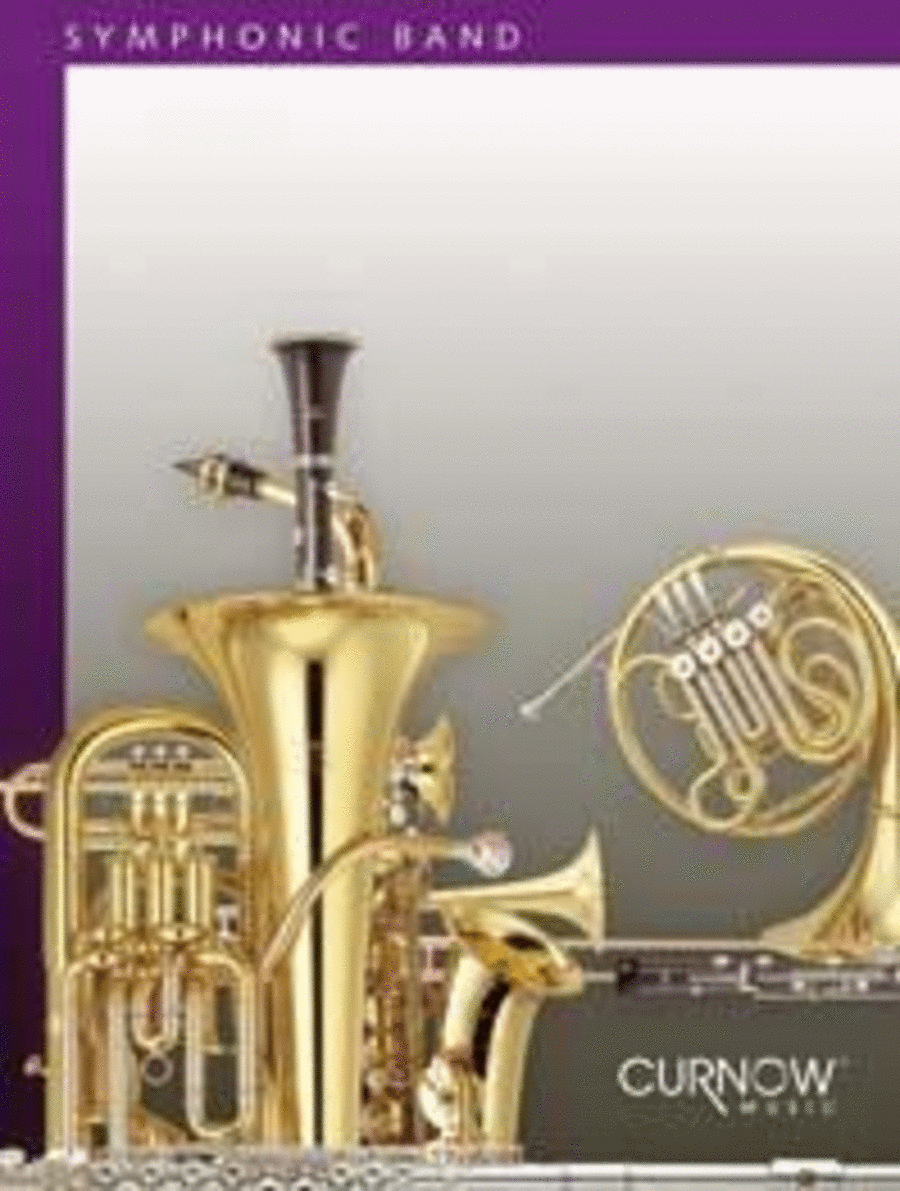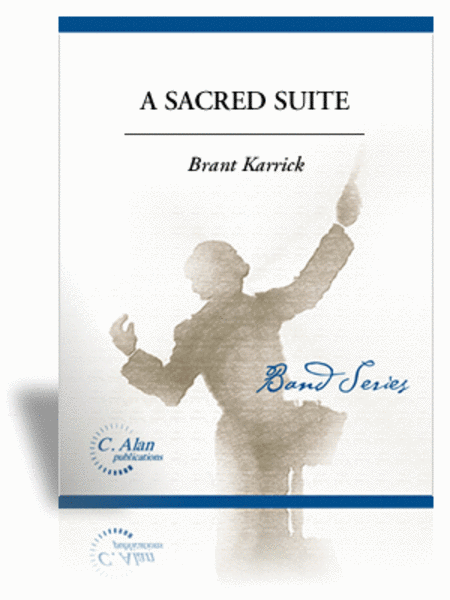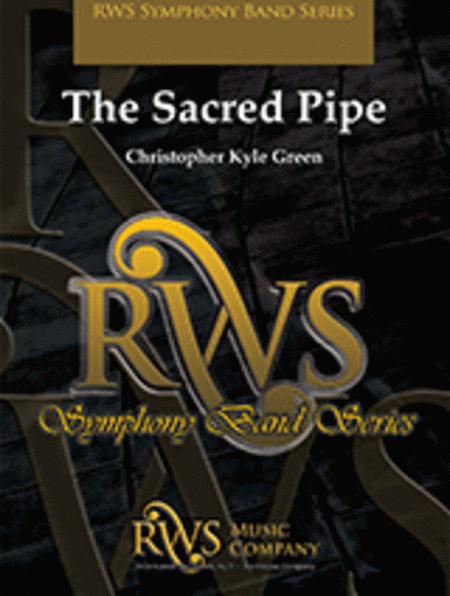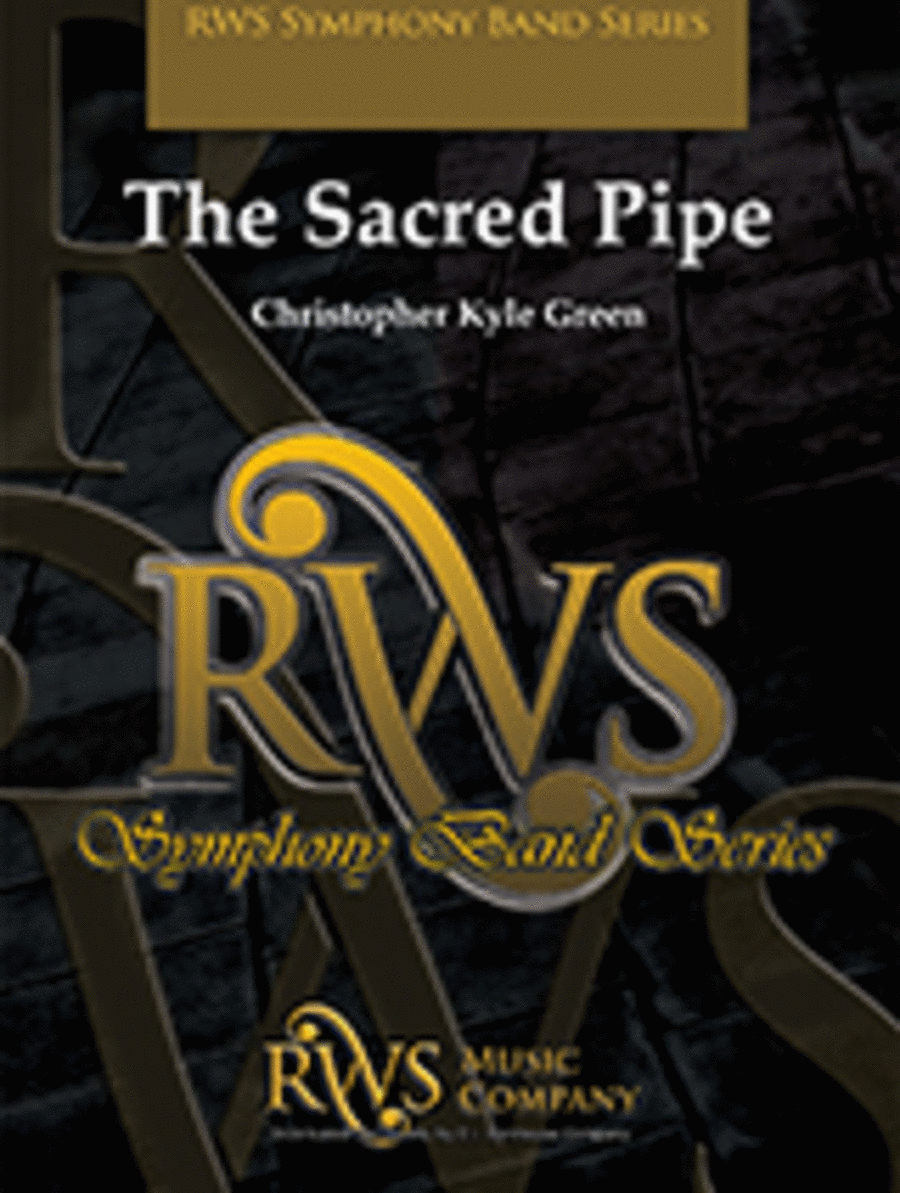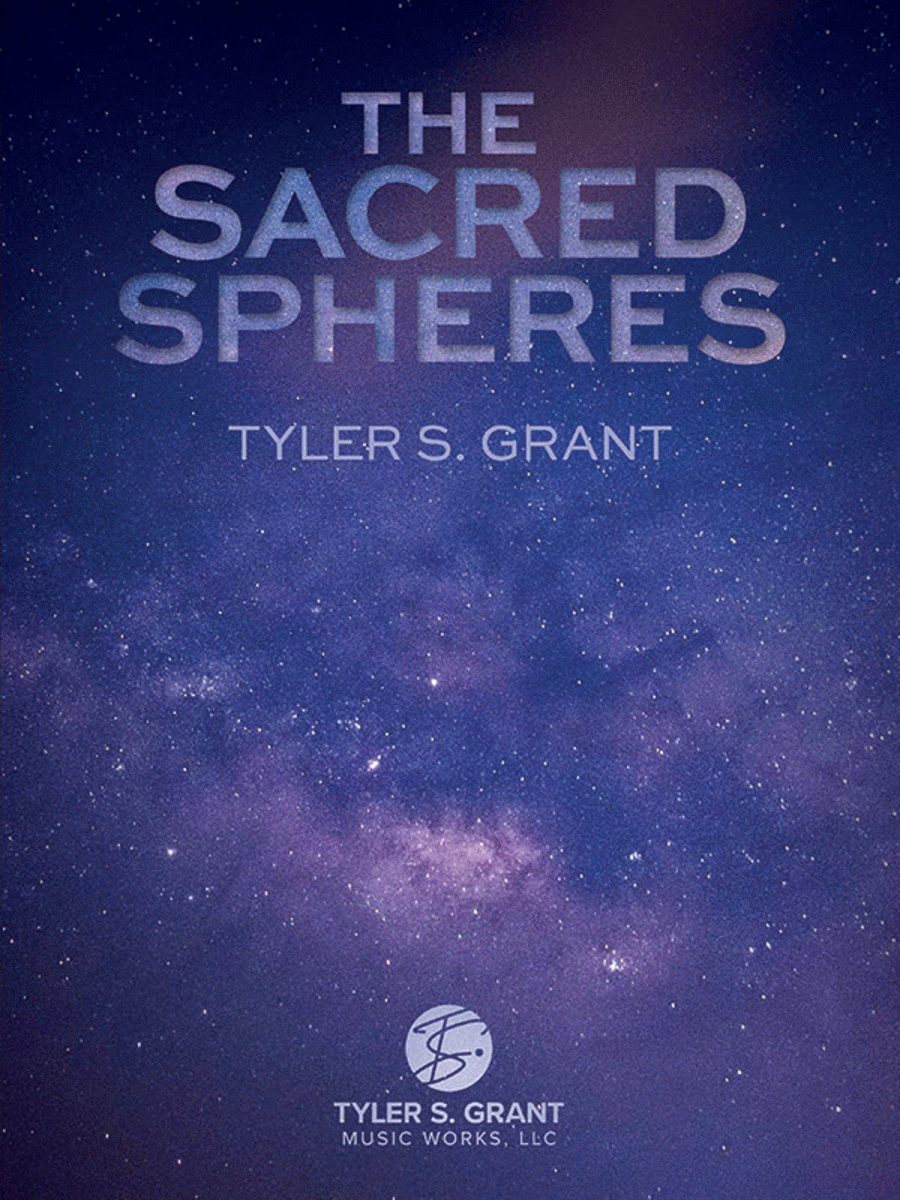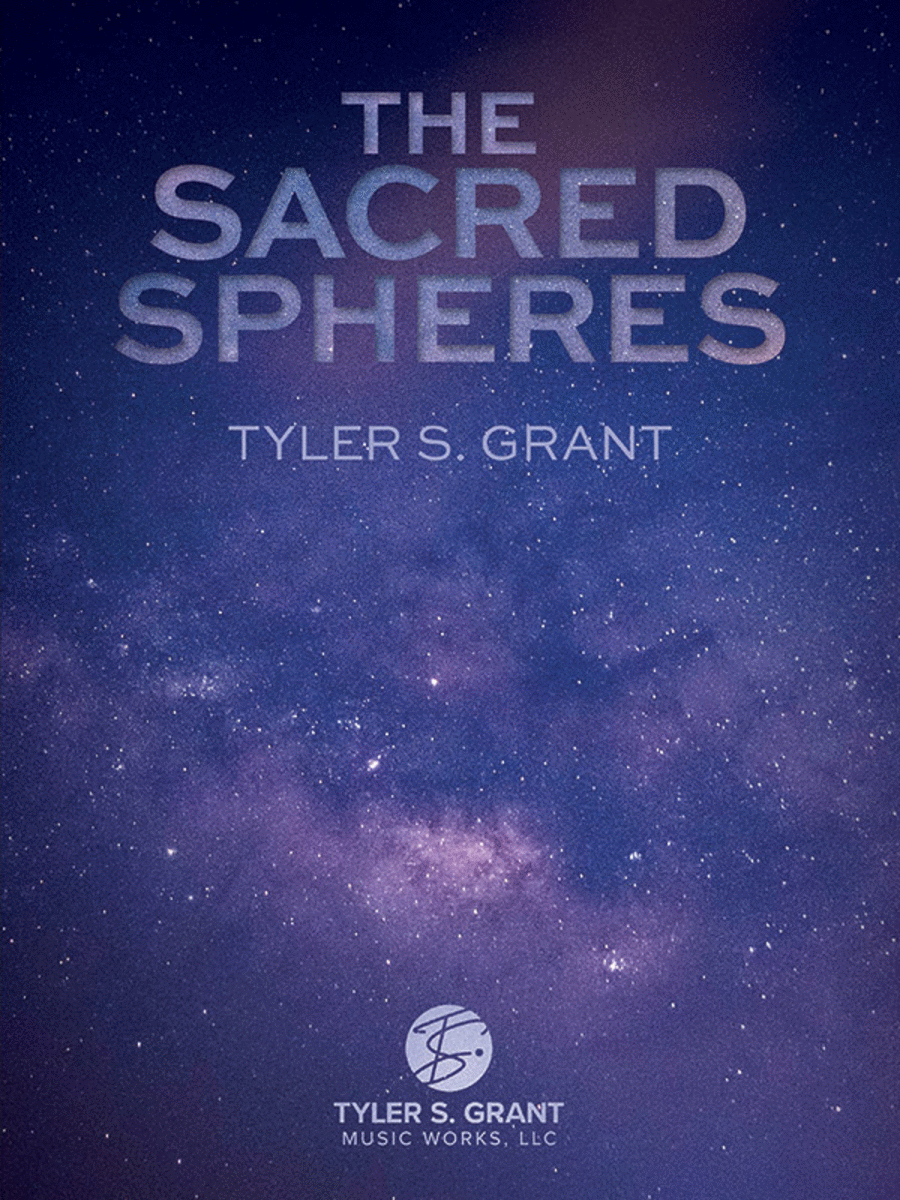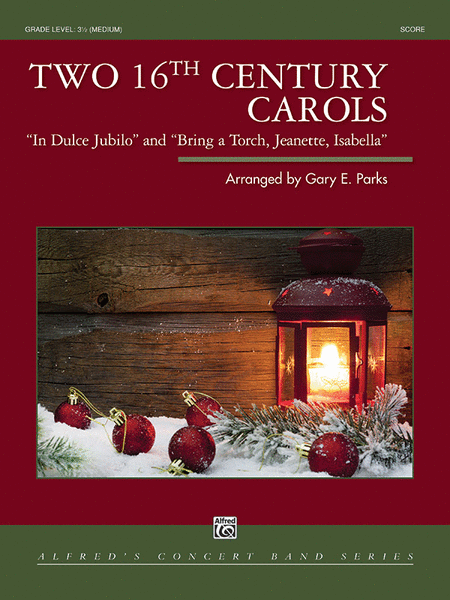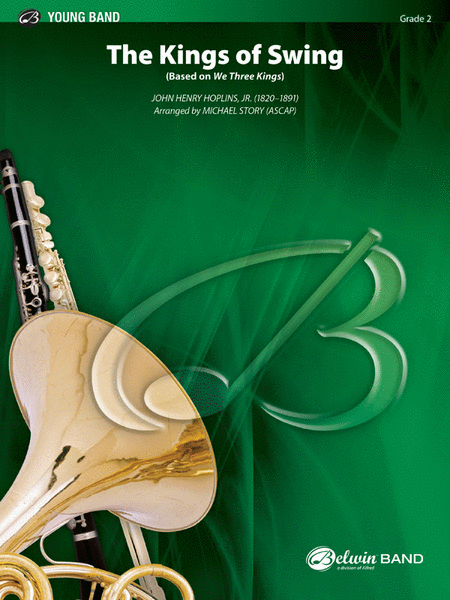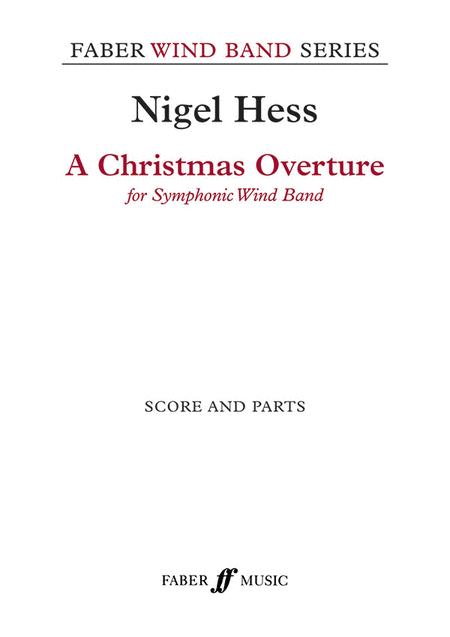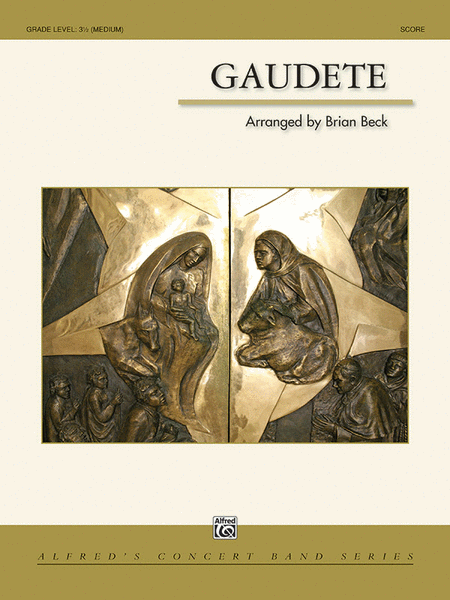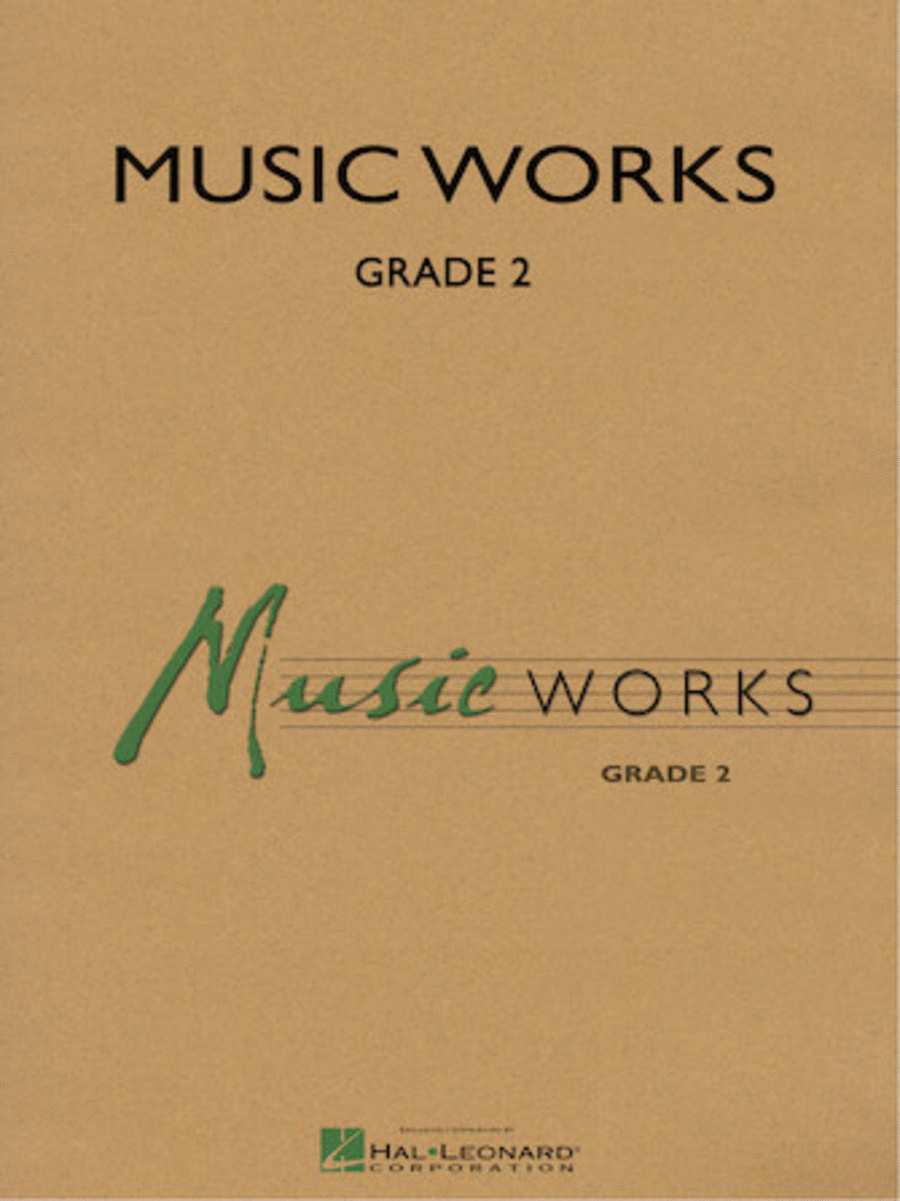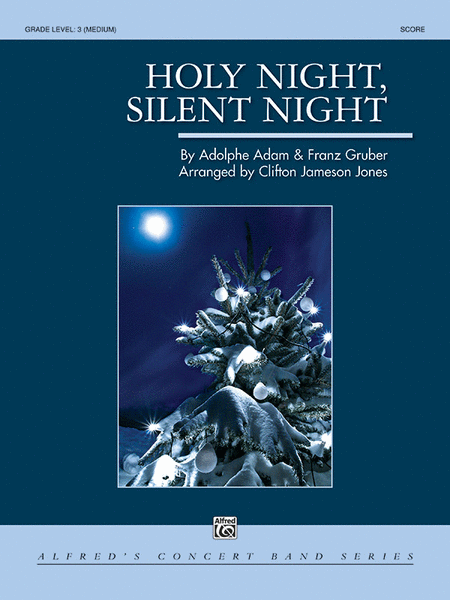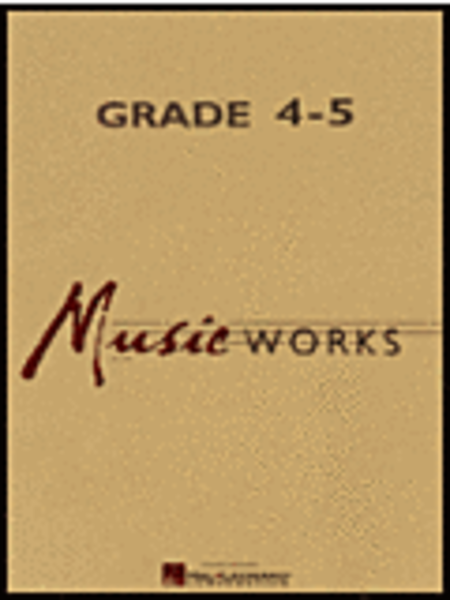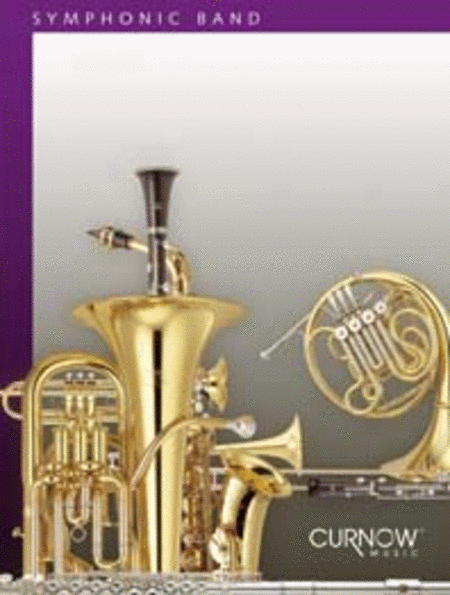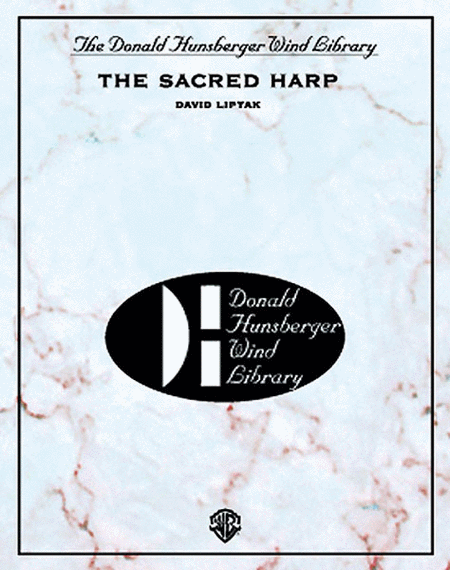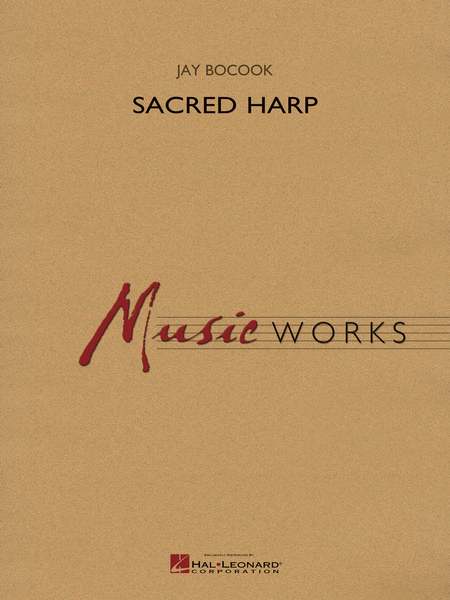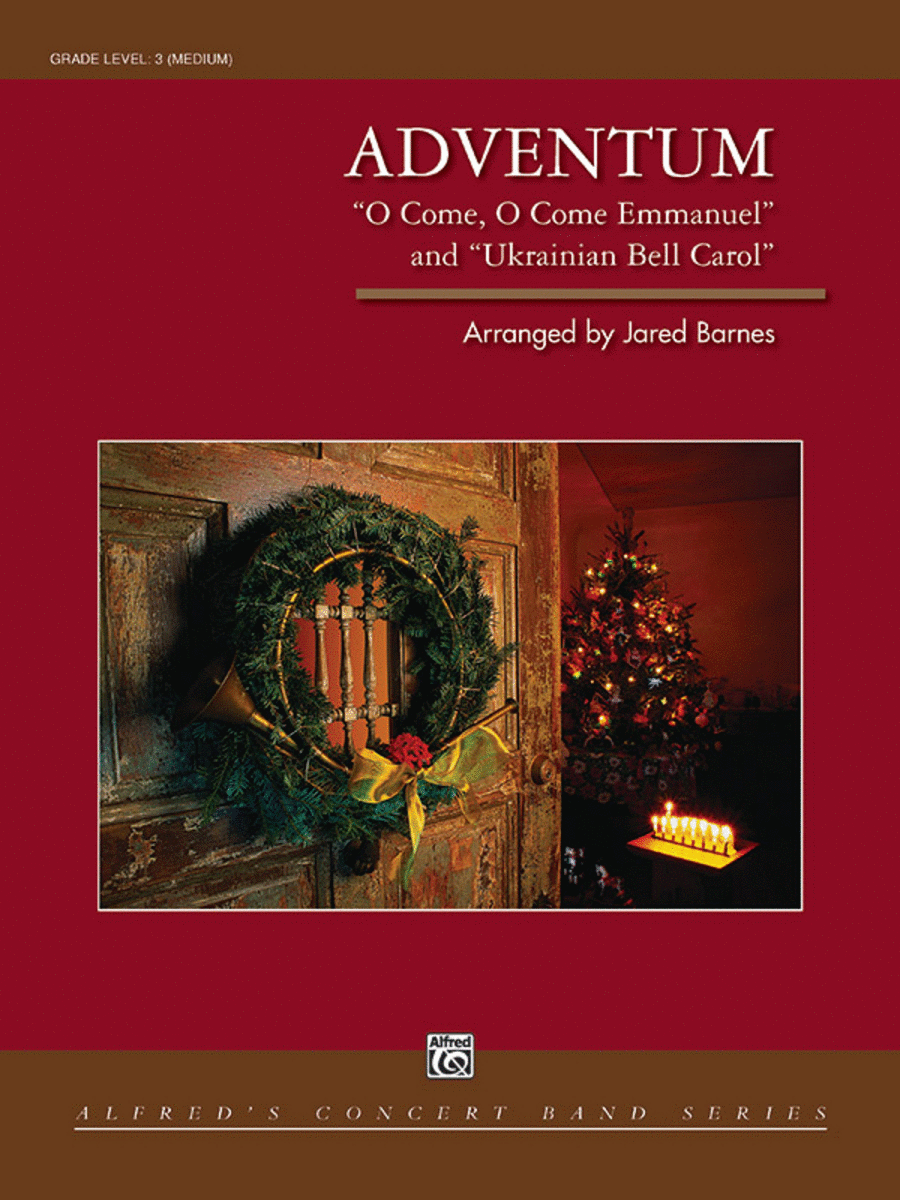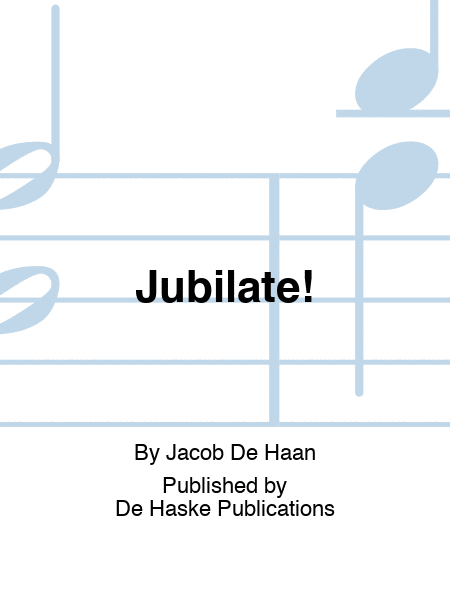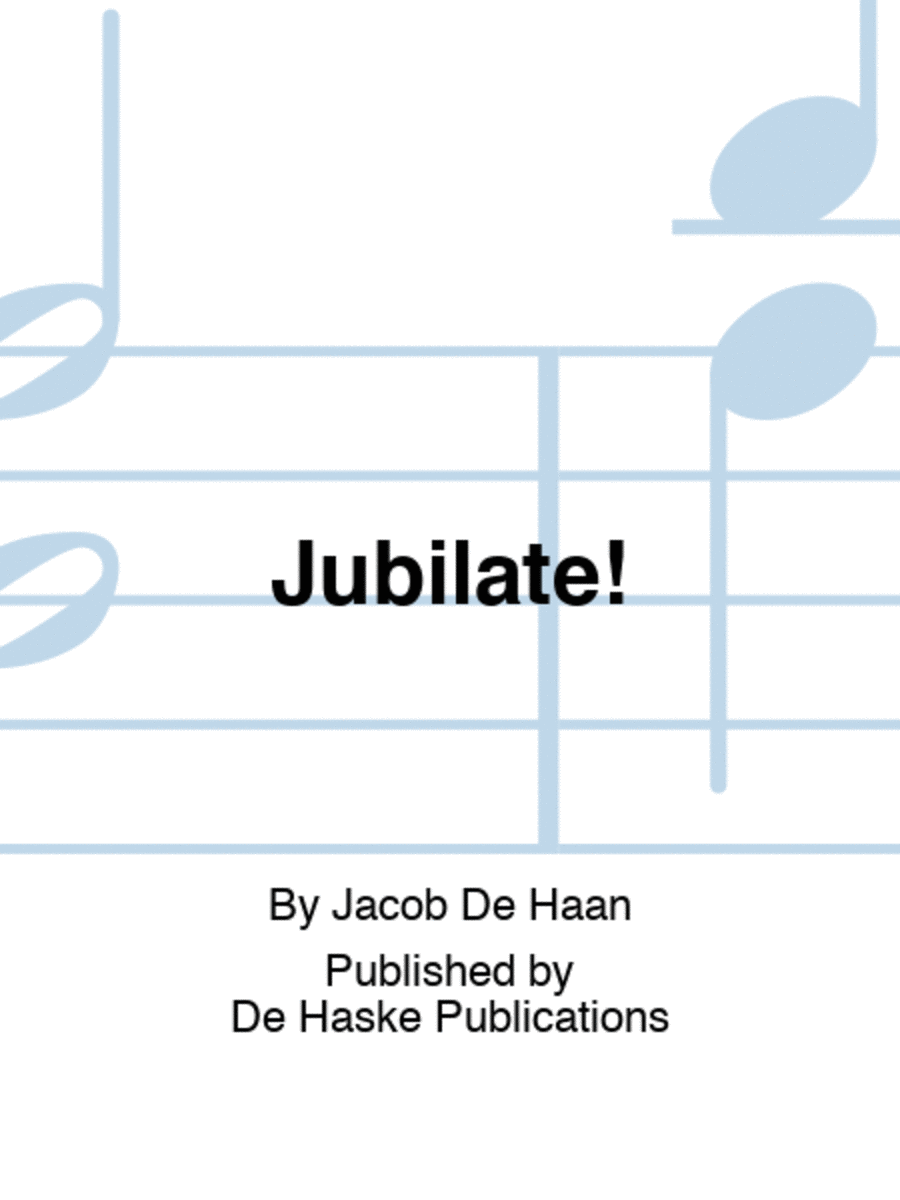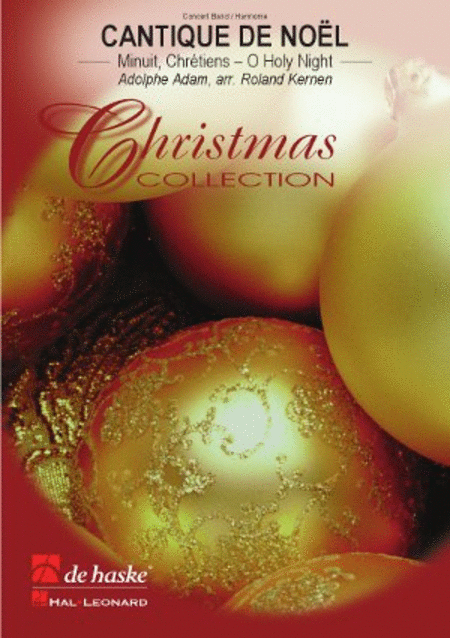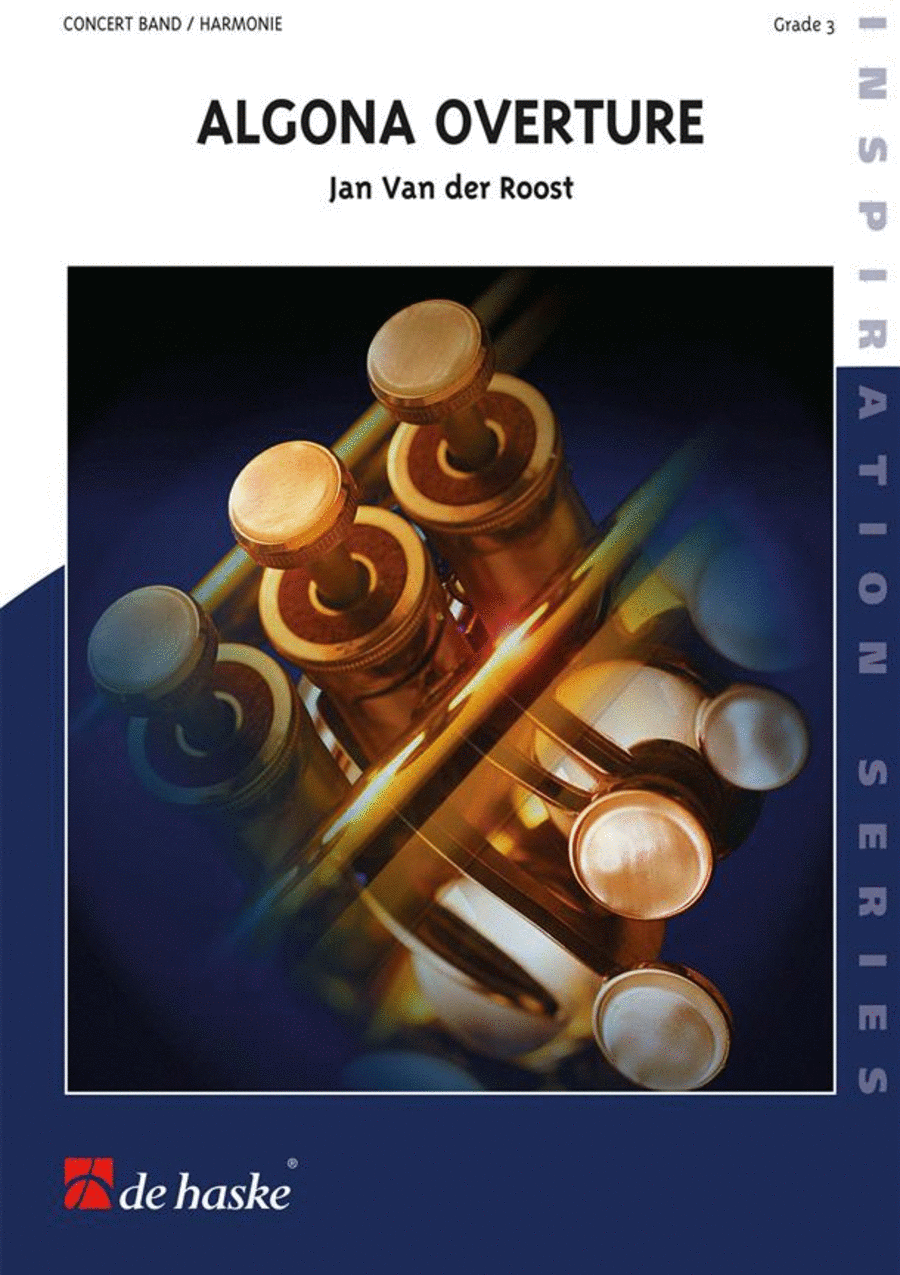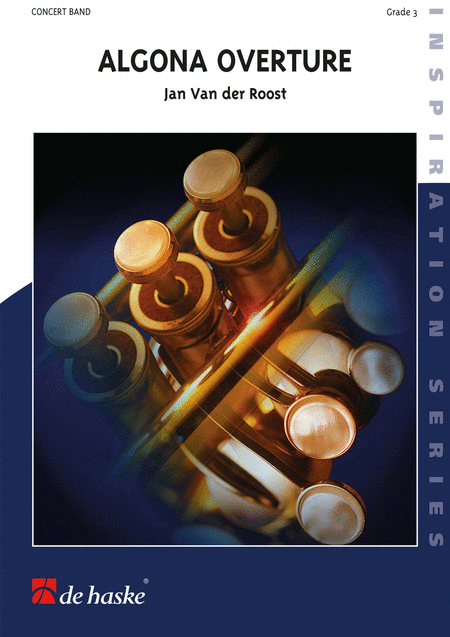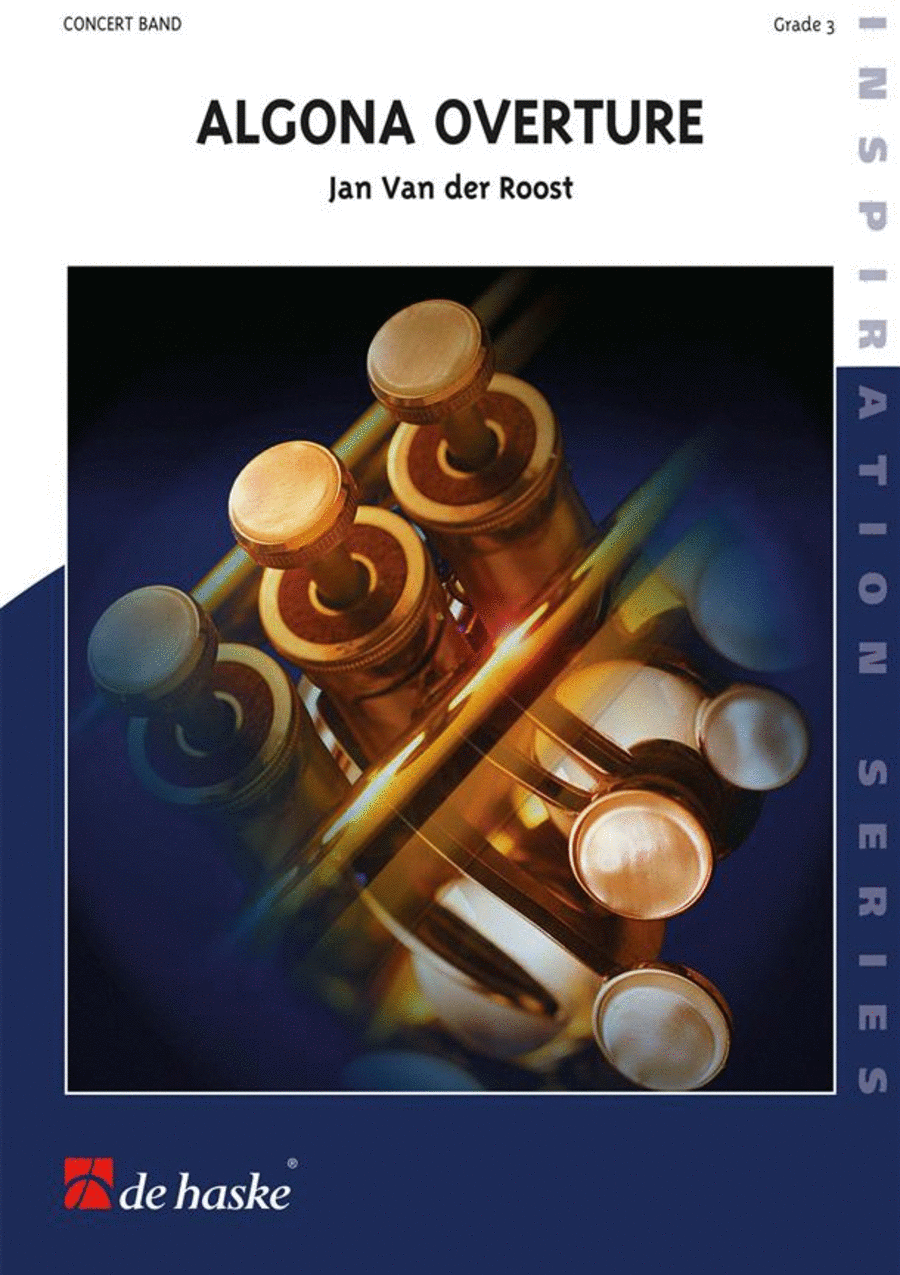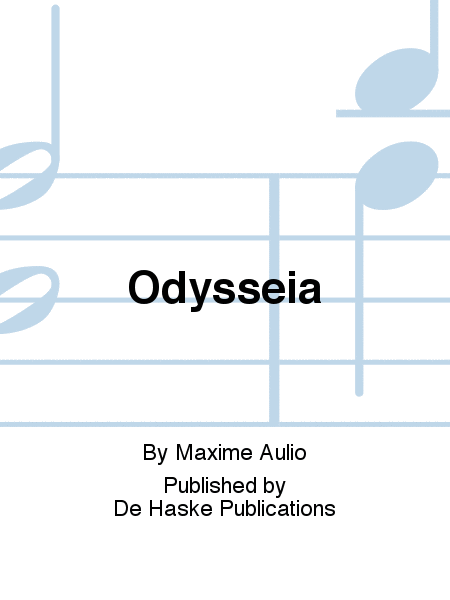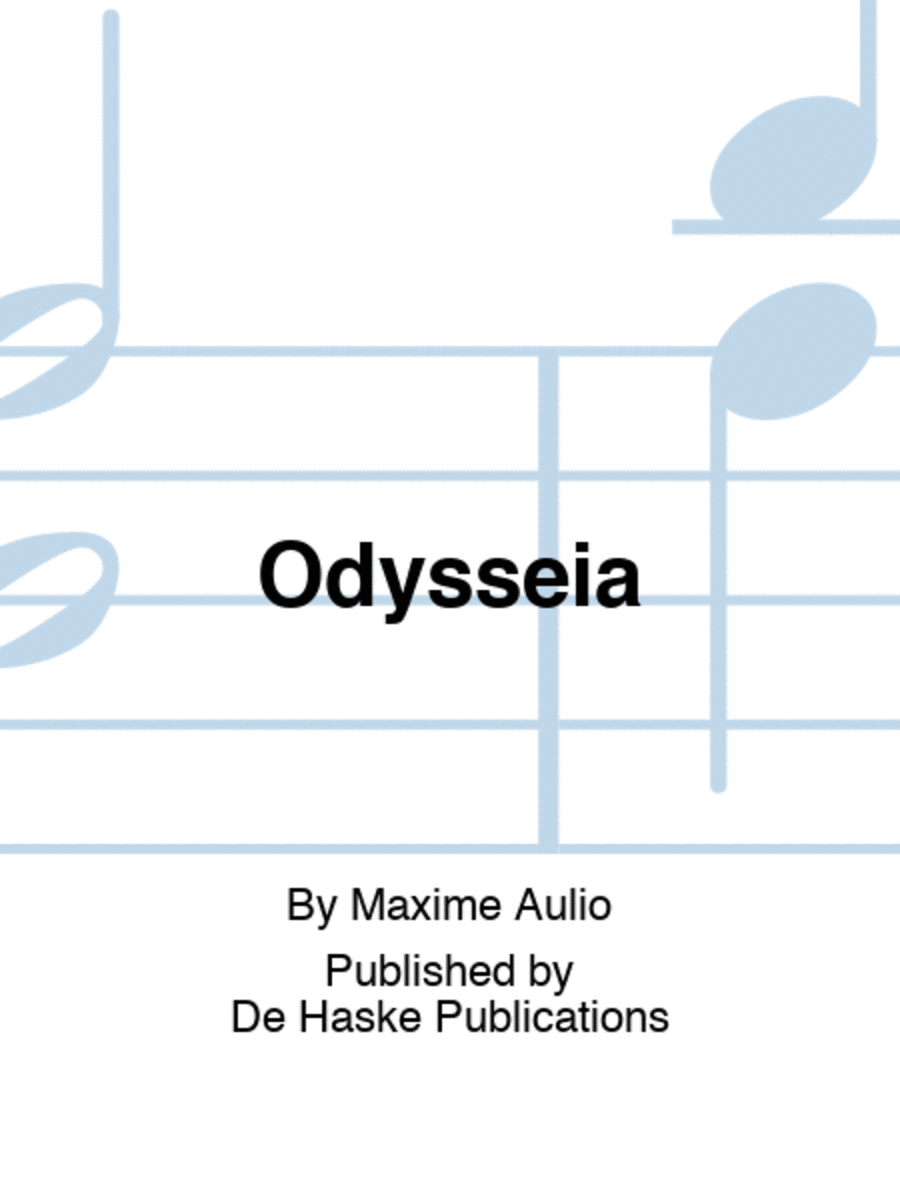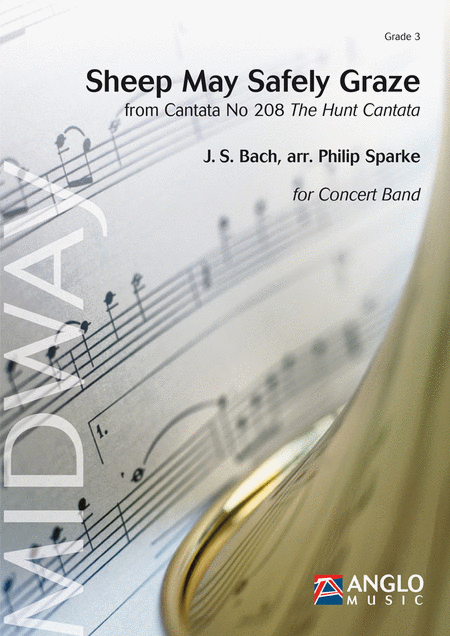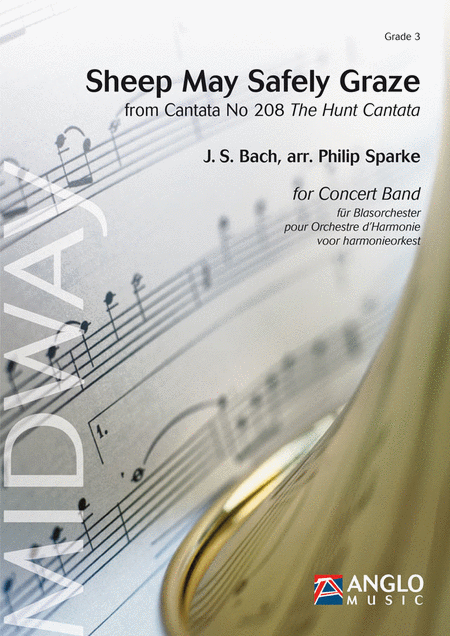|
| Inventions from the Sacred Harp
Orchestre d'harmonie [Conducteur et Parties séparées] - Intermédiaire
Curnow Music
Concert Band/Harmonie - Grade 5 SKU: BT.CMP-0916-05-010 Composed by James...(+)
Concert Band/Harmonie -
Grade 5 SKU:
BT.CMP-0916-05-010
Composed by James Curnow.
Symphonic Band. Concert
Piece. Set (Score &
Parts). Composed 2005.
Curnow Music #CMP
0916-05-010. Published by
Curnow Music
(BT.CMP-0916-05-010).
English. We urge
you to look at this
important new composition
by James Curnow. This
symphonic variant style
treatment of themes based
on the shape-note tune
Resignation is a
magnificent compositional
exploration. Once your
group has achieved the
ability to perform at
this level of difficulty,
they deserve to play
music with the challenge
and masterful quality
that Inventions from the
Sacred Harp
presents. Even a brief
analysis of the score
reveals composition and
development techniques
that are reserved for
pieces on an impressive
scale. A more thorough
analysis lets you
appreciate the complexity
of the compositional
processes found in the
very fabric of this major
work.The historical
significance of The
Sacred Harp provides
the opportunity for some
cross-curricular work as
well.
Wanneer uw
orkest een bepaald niveau
heeft bereikt, kunt u
uitpakken met
Inventions from the
Sacred Harp. James
Curnow ontwikkelde
variaties in diverse
stijlen, gebaseerd op het
in Amerikaanse
‘shape
notes’ geschreven
stukResignation uit de
beroemde Sacred
Harp-collectie,
waarin liederen, hymnen,
psalmmelodieën en
volksliedbewerkingen van
vroege Amerikaanse
componisten zijn
opgenomen. Een complex,
niet onder één
stijl onder te brengen
werk datindrukwekkend is
voor zowel muzikanten als
publiek.
Wenn Ihr
Blasorchester ein
gewisses spielerisches
Niveau erreicht hat,
sollten Sie es mit einem
Stück wie
Inventions from the
Sacred Harp belohnen.
James Curnow entwickelte
Variationen in
verschiedenen Stilen,
basierend auf dem in so
genannten shaped
notes“
geschriebenen Stück
Resignation aus dem
berühmten Liederbuch
The Sacred Harp,
das Lieder, Hymnen,
Psalmenmelodien und
Volksliedbearbeitungen
früher amerikanischer
Komponisten enthält.
Ein komplexes, Genre
übergreifendes Werk
voll von besonderen
Kompositionsund
Entwicklungstechniken,
das Musiker und Publikum
tief beeindrucken
wird!
The
Sacred Harp (La Harpe
Sacrée) est un livre
de chants religieux
nés dans le Sud rural
des États- Unis au
XIXe siècle. James
Curnow a puisé dans le
vaste trésor que
forment ces psaumes et
mélodies polyphoniques
chantés a capella et
écrits en notation
différenciée.
Inventions from The
Sacred Harp est un
ensemble
d’inventions qui
constituent une série
de variations sur la
mélodie du Psaume
23. $184.95 - Voir plus => AcheterDélais: 2 to 3 weeks | | | |
| A Sacred Suite
Orchestre d'harmonie [Conducteur et Parties séparées] - Intermédiaire
C. Alan Publications
By Brant Karrick. For Concert Band (Piccolo, Flute 1/2, Oboe, Bassoon, Clarinet ...(+)
By Brant Karrick. For
Concert Band (Piccolo,
Flute 1/2, Oboe, Bassoon,
Clarinet in Bb 1/2,
Clarinet in Bb 3, Bass
Clarinet, Alto Saxophone
1/2, Tenor Saxophone,
Baritone Saxophone,
Trumpet in Bb 1, Trumpet
in Bb 2/3, Horn in F 1/2,
Trombone 1, Trombone 2/3,
Euphonium, (Baritone
T.C.), Tuba,). Band
Music. Pioneer Band
Series. Grade 3. Score
and parts. Duration 7:20.
Published by C. Alan
Publications
$75.00 $71.25 (- 5%) Voir plus => AcheterDélais: 3 to 4 weeks | | | |
| The Sacred Pipe
Orchestre d'harmonie [Conducteur et Parties séparées] - Intermédiaire
RWS Music Company
Grade 4 SKU: CL.RWS-2031-00 Composed by Green. Concert Band. RWS Symphony...(+)
Grade 4 SKU:
CL.RWS-2031-00
Composed by Green.
Concert Band. RWS
Symphony Band Series.
Score and set of parts.
Composed 2020. Duration 8
minutes, 49 seconds. RWS
Music Company
#RWS-2031-00. Published
by RWS Music Company
(CL.RWS-2031-00).
A mysterious
work, The Sacred Pipe is
the musical endeavor of a
Native Cherokee myth.
Extravagant melodic
lines, tender harmonies,
fast and intense tempos,
and majestic fanfares
ensure a film-like
experience for the
audience. Join the Arrow
Woman on her journey
through the land, as she
fights against the norms
of her tribe. The Sacred
Pipe hopes to convey a
musical journey that
engulfs the grandiosity
of the land, the majesty
of mountains, and the
purity of water. $150.00 - Voir plus => AcheterDélais: 1 to 2 weeks | | | |
| The Sacred Pipe
Orchestre d'harmonie [Conducteur] - Intermédiaire
RWS Music Company
Grade 4 SKU: CL.RWS-2031-01 Composed by Green. Concert Band. Extra full S...(+)
Grade 4 SKU:
CL.RWS-2031-01
Composed by Green.
Concert Band. Extra full
Score. Composed 2020. RWS
Music Company
#RWS-2031-01. Published
by RWS Music Company
(CL.RWS-2031-01).
A mysterious
work, The Sacred Pipe is
the musical endeavor of a
Native Cherokee myth.
Extravagant melodic
lines, tender harmonies,
fast and intense tempos,
and majestic fanfares
ensure a film-like
experience for the
audience. Join the Arrow
Woman on her journey
through the land, as she
fights against the norms
of her tribe. The Sacred
Pipe hopes to convey a
musical journey that
engulfs the grandiosity
of the land, the majesty
of mountains, and the
purity of water. $15.00 - Voir plus => AcheterDélais: 1 to 2 weeks | | | |
| The Sacred Spheres
Orchestre d'harmonie [Conducteur et Parties séparées]
Peters
Composed by Tyler S. Grant. Concert Band; Performance Music Ensemble. Tyler ...(+)
Composed by Tyler S.
Grant.
Concert Band; Performance
Music Ensemble. Tyler S.
Grant
Music Works. Score and
Part(s). Edition Peters
#98-
TSGB026. Published by
Edition
Peters
$245.00 - Voir plus => AcheterDélais: 1 to 2 weeks | | | |
| The Sacred Spheres
Orchestre d'harmonie [Conducteur] - Avancé
Peters
Concert Band Pending - Advanced; Grade 5 SKU: PE.TSGB026S Composed by Tyl...(+)
Concert Band Pending -
Advanced; Grade 5 SKU:
PE.TSGB026S Composed
by Tyler S. Grant.
Concert Band; Performance
Music Ensemble. Tyler S.
Grant Music Works. Score.
Edition Peters
#98-TSGB026S. Published
by Edition Peters
(PE.TSGB026S). UPC:
038081585109. The
Sacred Spheres by Tyler
S. Grant is written in
two contrasting
movements. The title of
the first movement, From
Harmony, from heav'nly
harmony..., comes
directly from the first
line of John Dryden's
poem, A Song for St.
Cecilia's Day. The first
few notes musically
depict the beginning of
the universal framework
described in the text
through delicate textures
and orchestrations that
develop as the movement
progresses. The second
stanza of the poem
highlights the capacity
for musical elements to
inspire passion, which is
represented at the climax
of the first movement.
The second
movement, Cries, hark the
foe comes, picks up the
poem from the third
stanza, highlighting the
spectrum of emotions that
can be summoned by
various instruments. The
beginning of the movement
highlights the trumpet's
loud clangor along with
drums that inspire war
and conflict. The
movement transitions to a
section of mourning
through the sound of a
warbling flute. The
ending of the movement
combines the final
stanzas along with the
Grand Chorus to
recapitulate earlier
material and create a
celebratory and impactful
finale.
Commissioned by a
consortium of bands in
honor of Randall O.
Coleman; Recorded by the
Kennesaw State University
Wind Ensemble. $55.00 - Voir plus => AcheterDélais: 1 to 2 weeks | | | |
| Two 16th Century Carols
Orchestre d'harmonie [Conducteur et Parties séparées] - Intermédiaire
Alfred Publishing
( In Dulci Jubilo and Bring a Torch, Jeanette Isabella ). Arranged by Gary E. ...(+)
( In Dulci Jubilo and
Bring a Torch, Jeanette
Isabella ). Arranged by
Gary E. Parks. Concert
Band. Concert Band;
Part(s); Score. Alfred
Concert Band. Christmas;
Sacred; Winter. Grade
3.5. 268 pages. Published
by Alfred Music
$78.00 - Voir plus => AcheterDélais: 1 to 2 weeks | | | |
| The Kings of Swing
Orchestre d'harmonie [Conducteur et Parties séparées] - Facile
Belwin
(Based on We Three Kings ). Composed by John Henry Hopkins Jr. (1820-1891). Arr...(+)
(Based on We Three Kings
). Composed by John Henry
Hopkins Jr. (1820-1891).
Arranged by Michael
Story. Concert Band.
Concert Band; Part(s);
Score. Belwin Young Band.
Christmas; Novelty;
Sacred; Swing; Winter.
Grade 2. 132 pages.
Published by Belwin Music
$57.00 - Voir plus => AcheterDélais: 1 to 2 weeks | | | |
| A Christmas Overture
Orchestre d'harmonie [Conducteur et Parties séparées]
Faber Music Limited
By Nigel Hess (1953-). Concert Band. For Wind Band. Part(s); Score; Wind Band. F...(+)
By Nigel Hess (1953-).
Concert Band. For Wind
Band. Part(s); Score;
Wind Band. Faber Edition:
Faber Wind Band Series.
20th Century; Christmas;
Masterwork; Sacred;
Secular; Winter.
Published by Faber Music
$115.00 $109.25 (- 5%) Voir plus => AcheterDélais: 1 to 2 weeks | | | |
| Gaudete
Orchestre d'harmonie [Conducteur et Parties séparées] - Intermédiaire
Alfred Publishing
Arranged by Brian Beck. Concert Band. Concert Band; Part(s); Score. Alfred Conce...(+)
Arranged by Brian Beck.
Concert Band. Concert
Band; Part(s); Score.
Alfred Concert Band.
Christmas; Sacred;
Winter. Grade 3.5. 288
pages. Published by
Alfred Music
$80.00 - Voir plus => AcheterDélais: 1 to 2 weeks | | | |
| Distant Thunder of the Sacred Forest
Orchestre d'harmonie - Facile
Hal Leonard
Score Only Concert Band (Score) - Grade 2 SKU: HL.4002107 Composed by Mic...(+)
Score Only Concert Band
(Score) - Grade 2 SKU:
HL.4002107 Composed
by Michael Sweeney.
MusicWorks Grade 2.
Concert. 28 pages.
Published by Hal Leonard
(HL.4002107). UPC:
884088074609.
9.0x12.0x0.055
inches. This
amazing work opens with
the sounds of distant
villages as their
drumming echoes through
the African rain forests
(or school gymnasium). As
the players return to
their â??normalâ?
seats in the band, the
various elements of this
composition gradually
come together in a joyous
unified celebration.
Thoroughly researched to
include authentic African
patterns, Michael Sweeney
has created a stunningly
effective work that is
playable by young
ensembles. Includes
performance and program
notes on how to make your
own percussion
instruments and involve
other departments in your
school. Not just a piece
of music...this is an
event! (4:45). $10.00 - Voir plus => AcheterDélais: 24 hours - In Stock | | | |
| Holy Night, Silent Night
Orchestre d'harmonie [Conducteur] - Intermédiaire
Alfred Publishing
Composed by Adolphe Adam and Franz Gruber. Arranged by Clifton Jameson Jones. Co...(+)
Composed by Adolphe Adam
and Franz Gruber.
Arranged by Clifton
Jameson Jones. Concert
Band. Concert Band;
Score. Alfred Concert
Band. Christmas; Sacred;
Winter. Grade 3. 16
pages. Published by
Alfred Music
$9.00 - Voir plus => AcheterDélais: 1 to 2 weeks | | | |
| Inventions from Sacred Harp
Orchestre d'harmonie - Intermédiaire
Curnow Music
Concert Band - Grade 5 SKU: HL.44005260 Grade 5 - Score Only. Comp...(+)
Concert Band - Grade 5
SKU: HL.44005260
Grade 5 - Score
Only. Composed by
James Curnow. Arranged by
James Curnow. Curnow
Music Concert Band. 45
pages. Curnow Music
#91605140. Published by
Curnow Music
(HL.44005260). UPC:
073999338157. 8.5x11
inches. Using a
symphonic variant style
(like that of Hindemith's
Symphonic
Metamorphosis), James
Curnow has written a
magnificent compositional
exploration of themes
based on the shape-note
tune
“Resignation.&rdquo
; Advanced groups love to
play music at this level
of challenge and
substance, and directors
will appreciate the
developmental techniques
woven into its fabric.
Add a history unit on
The Sacred Harp
for some cross-curricular
work. $28.95 - Voir plus => AcheterDélais: 24 hours - In Stock | | | |
| Sacred Harp
Orchestre d'harmonie [Conducteur] - Intermédiaire/avancé
Hal Leonard
By Jay Bocook. For Concert Band (Score). MusicWorks Grade 5. Grade 5. 48 pages. ...(+)
By Jay Bocook. For
Concert Band (Score).
MusicWorks Grade 5. Grade
5. 48 pages. Published by
Hal Leonard
$25.00 - Voir plus => AcheterDélais: 24 hours - In Stock | | | |
| Inventions from Sacred Harp
Orchestre d'harmonie
Curnow Music
Curnow Music Symphonic Band. By James Curnow. Curnow Concert Band Full Set. Publ...(+)
Curnow Music Symphonic
Band. By James Curnow.
Curnow Concert Band Full
Set. Published by Curnow
Music.
(1)$129.00 - Voir plus => AcheterDélais: 24 hours - In Stock | | | |
| The Sacred Harp
Orchestre d'harmonie
Alfred Publishing
By David Liptak. By David Liptak. For Concert Band. Concert Band. Donald Hunsber...(+)
By David Liptak. By David
Liptak. For Concert Band.
Concert Band. Donald
Hunsberger Wind Library.
Level: 5 (Medium
Advanced) (grade 5).
Conductor Score and
Parts. 259 pages.
Published by Alfred
Publishing.
$125.00 - Voir plus => AcheterDélais: 1 to 2 weeks | | | |
| Sacred Harp
Orchestre d'harmonie [Conducteur et Parties séparées]
Hal Leonard
Composed by Jay Bocook. For Concert Band (Score and Parts). MusicWorks Grade 5. ...(+)
Composed by Jay Bocook.
For Concert Band (Score
and Parts). MusicWorks
Grade 5. Grade 5.
Published by Hal Leonard
$195.00 - Voir plus => AcheterDélais: 24 hours - In Stock | | | |
| Adventum (O Come, O Come Emmanuel / Ukrainian Bell Carol)
Orchestre d'harmonie [Conducteur et Parties séparées] - Intermédiaire
Alfred Publishing
(O Come, O Come Emmanuel / Ukrainian Bell Carol). Arranged by Jared Barnes. Conc...(+)
(O Come, O Come Emmanuel
/ Ukrainian Bell Carol).
Arranged by Jared Barnes.
Concert Band. Concert
Band; Part(s); Score.
Alfred Concert Band.
Christmas; Sacred;
Secular; Winter. Grade 3.
206 pages. Published by
Alfred Music
$80.00 $76 (- 5%) Voir plus => AcheterDélais: 1 to 2 weeks | | | |
| Jubilate!
Orchestre d'harmonie [Conducteur] - Facile
De Haske Publications
Concert Band/Harmonie - Grade 3 SKU: BT.DHP-1094722-140 Waldkircha in ...(+)
Concert Band/Harmonie -
Grade 3 SKU:
BT.DHP-1094722-140
Waldkircha in
Musica. Composed by
Jacob De Haan. Concert
and Contest Collection
CBHA. Concert Piece.
Score Only. Composed
2009. 36 pages. De Haske
Publications #DHP
1094722-140. Published by
De Haske Publications
(BT.DHP-1094722-140).
9x12 inches.
English-German-French-Dut
ch. Jubilateâ�
�™s main theme
comes from the Gregorian
chant on the Psalm
Jubliate Deo omnis terra.
The work itself was
inspired by the
sacredhistory of the
Waldkirch (a forest
village) community,
located on the
Swiss/German boarder. It
tells a tale of the Irish
and Scottish monks who
build the first wooden
church at the site of
what is now Waldkirch, of
the dramatic events, good
and bad, that have taken
place over the centuries
and of the flourishing
community that has
withstood the trials of
time.
Jubilate!
, dessen Hauptthema
aus dem gregorianischen
Gesang zum Psalm
Jubilate Deo omnis
terra stammt, wurde
von der Kirchengeschichte
der Gemeinde Waldkirch
bei Waldshut am Hochrhein
inspiriert. Von den
irischen und schottischen
Mönchen, welche die
erste Holzkirche bauten,
von dramatischen
historischen Ereignissen,
aber auch von einer
aufblühenden
Kirchengemeinde handelt
dieses festliche Werk,
dem eine CD mit dem
Glockenklang der
Waldkircher Kirche
beiliegt.
Jacob de
Haan fa rivivere il
passato religioso di
Waldkirch, una citt
tedesca vicino alla
frontiera con la
Svizzera. Il titolo del
brano deriva dal versetto
del Salmo 97
Jubilate Deo omnis
terra. La musica rievoca
l’arrivo dei
monaci scozzesi ed
irlandesi che si
stabilirono sul suolo
dell’attuale
Waldkirch dove iniziarono
a costruire le prime
chiese. La storia prende
in seguito una piega
più tragica, ma la
comunit reagisce
positivamente e con
orgoglio, ciò che
porta alla prosperit e al
benessere. Le campane di
Waldkirch suonano con
vigore (CD di
accompagnamento):
Jubilate! $38.95 - Voir plus => AcheterDélais: 2 to 3 weeks | | | |
| Jubilate!
Orchestre d'harmonie [Conducteur et Parties séparées] - Facile
De Haske Publications
Concert Band/Harmonie - Grade 3 SKU: BT.DHP-1094722-013 Waldkircha in ...(+)
Concert Band/Harmonie -
Grade 3 SKU:
BT.DHP-1094722-013
Waldkircha in
Musica. Composed by
Jacob De Haan. Concert
and Contest Collection
CBHA. Concert Piece. Set
(Score & Parts) with CD.
Composed 2009. De Haske
Publications #DHP
1094722-013. Published by
De Haske Publications
(BT.DHP-1094722-013).
9x12 inches.
English-German-French-Dut
ch. Jubilateâ�
�™s main theme
comes from the Gregorian
chant on the Psalm
Jubliate Deo omnis terra.
The work itself was
inspired by the
sacredhistory of the
Waldkirch (a forest
village) community,
located on the
Swiss/German boarder. It
tells a tale of the Irish
and Scottish monks who
build the first wooden
church at the site of
what is now Waldkirch, of
the dramatic events, good
and bad, that have taken
place over the centuries
and of the flourishing
community that has
withstood the trials of
time.
Jubilate!
, dessen Hauptthema
aus dem gregorianischen
Gesang zum Psalm
Jubilate Deo omnis
terra stammt, wurde
von der Kirchengeschichte
der Gemeinde Waldkirch
bei Waldshut am Hochrhein
inspiriert. Von den
irischen und schottischen
Mönchen, welche die
erste Holzkirche bauten,
von dramatischen
historischen Ereignissen,
aber auch von einer
aufblühenden
Kirchengemeinde handelt
dieses festliche Werk,
dem eine CD mit dem
Glockenklang der
Waldkircher Kirche
beiliegt.
Jacob de
Haan fa rivivere il
passato religioso di
Waldkirch, una citt
tedesca vicino alla
frontiera con la
Svizzera. Il titolo del
brano deriva dal versetto
del Salmo 97
Jubilate Deo omnis
terra. La musica rievoca
l’arrivo dei
monaci scozzesi ed
irlandesi che si
stabilirono sul suolo
dell’attuale
Waldkirch dove iniziarono
a costruire le prime
chiese. La storia prende
in seguito una piega
più tragica, ma la
comunit reagisce
positivamente e con
orgoglio, ciò che
porta alla prosperit e al
benessere. Le campane di
Waldkirch suonano con
vigore (CD di
accompagnamento):
Jubilate! $184.95 - Voir plus => AcheterDélais: 2 to 3 weeks | | | |
| Cantique de Noel
Orchestre d'harmonie [Conducteur] - Facile
De Haske Publications
Concert Band/Harmonie - Grade 2 SKU: BT.DHP-1053882-140 Minuit, Chr�...(+)
Concert Band/Harmonie -
Grade 2 SKU:
BT.DHP-1053882-140
Minuit, Chrétiens -
O Holy Night.
Arranged by Roland
Kernen. Christmas
Collection. Sacred. Score
Only. Composed 2005. 16
pages. De Haske
Publications #DHP
1053882-140. Published by
De Haske Publications
(BT.DHP-1053882-140).
9x12 inches.
English-German-French-Dut
ch. Adams kerstlied
Cantique de
Noël (in Frankrijk
bekender als Minuit,
Chrétiens en in
het Engels populair als
O Holy Night) werd
in eerste instantie
bekritiseerd door de
kerkelijke autoriteiten,
die een gebrek
aanmuzikale smaak en de
afwezigheid van
religieuze beleving
constateerden. Hoezeer
zij het bij het verkeerde
eind hadden is intussen
gebleken: het lied is
wereldwijd geliefd en
wordt nog altijd veel
gezongen - ook in kerken.
RolandKernen maakte van
Cantique de
Noël een
sfeervolle bewerking voor
blaasorkest.
Dem
Weihnachtslied
Cantique de
Noël von Adolphe
Charles Adam aus dem 19.
Jahrhundert wurde damals
von Kirchenoberen einen
Mangel an gutem Geschmack
und das Fehlen von
religiösem Empfinden
bescheinigt. Doch sie
irrten sich: Das Lied ist
auf der ganzen Welt
beliebt und wird noch
immer oft gesungen - auch
in Kirchen. Roland Kernen
legt hier eine
wunderschöne Version
für Blasorchester vor.
Le compositeur
français Adolphe
Charles Adam (1803-1856)
est initié la musique
par son père
Jean-Louis Adam,
professeur de piano au
Conservatoire de Paris.
En 1821, il entre au
Conservatoire de Paris
dans la classe
d’orgue et
d’harmonium de
François Benoist et
celle de Bo eldieu pour
la composition. Vers les
années 1823, il
connaît ses premiers
succès gr ce ses
chansons composées
pour des vaudevilles
parisiens. Il assied sa
notoriété avec ses
ballets, notamment avec
le gracieux
Giselle, et
quelques
opéras-comiques. Vers
la fin de sa vie, il est
nommé professeur de
composition au
Conservatoire de Paris.
En 1847, Adolphe Adam
compose le Cantique de
Noël surle
poème Minuit,
Chrétiens de
Placide Cappeau.
L’Église
émet de vives
critiques
l’encontre de la
musique jugée trop
pompeuse et du texte trop
pa en. Bien tort, car le
noël d’Adam
éblouira le monde
entier. Il est
interprété encore
de nos jours, même
dans les églises.
Roland Kernen en a
réalisé ce bel
arrangement pour
Orchestre
d’Harmonie. $17.95 - Voir plus => AcheterDélais: 2 to 3 weeks | | | |
| Algona Overture
Orchestre d'harmonie [Conducteur et Parties séparées] - Facile
De Haske Publications
Concert Band/Harmonie - Grade 3 SKU: BT.DHP-1053750-010 Composed by Jan V...(+)
Concert Band/Harmonie -
Grade 3 SKU:
BT.DHP-1053750-010
Composed by Jan Van der
Roost. Inspiration
Series. Concert Piece.
Set (Score & Parts).
Composed 2005. 48 pages.
De Haske Publications
#DHP 1053750-010.
Published by De Haske
Publications
(BT.DHP-1053750-010).
English-German-French-
Dutch. This piece
is dedicated to all the
citizens who live, have
lived, and will live in
the US town of Algona,
who commissioned the work
to celebrate it’s
150th anniversary. With
dark-tinted tones (low
drums, heavy brass), this
overture begins with a
primitive sacred feel, it
seems as if centuries-old
Indian singing is heard
once more. Gradually the
sound becomes clearer and
brighter as the same
theme travels throughout
the band in various
guises and variants.
Imposing tutti passages
then give the band the
chance to lavishly shine.
This bright and catchy
overture radiates
spontaneous energy and as
it features every section
of the band all the
players as well as the
listenersare continually
surprised and captivated.
Met donkere tonen
begint deze ouverture
sacraal en bezwerend: het
lijkt of eeuwenoude
indianengezangen weer tot
klinken komen.
Geleidelijk wordt het
klankbeeld helderder:
hetzelfde thema maakt in
diverse varianten als het
ware eenronde door het
orkest. Met een paar
imposante tuttipassages
kan het orkest goed
uitpakken. Nadien komt
een energiek allegro met
een krachtige thematiek
naar voren, gevolgd door
een lyrisch gegeven. Deze
ingrediënten wisselen
elkaaraf op weg naar een
opwindende finale. Het
klankidioom is zeer
toegankelijk en alle
geledingen van het orkest
komen aan
bod!
Anlässlich
der 150-Jahrfeier der
Stadt Algona im US-Staat
Iowa komponiert, strahlt
diese klare,
eingängige
Ouvertüre spontane
Energie aus. Zwar beginnt
das Werk sakral und
flehend mit dunkel
gefärbten Tönen,
doch allmählich wird
der Klang klarer und
heller, während das
Thema in verschiedenen
Gewändern und
Varianten durch das
Blasorchester wandert.
Dem folgenden energischen
Allegro folgt ein
lyrisches Thema, und
beide Elemente
verschmelzen
schließlich in einem
aufregenden Finale. Alle
Register des
Blasorchesters werden
hier beleuchtet, sodass
sowohl Spieler als auch
Zuhörer fortwährend
überrascht und
bezaubert
werden.
Algona
Overture
s’ouvre dans un
univers sonore aux
couleurs sombres. La
musique revêt une
dimension sacrée, un
esprit de supplication.
Un chant indien vieux de
plusieurs siècles
résonne comme un chant
oublié.
D’imposants
passages tutti
dévoilent les
somptueuses facettes de
l’Orchestre
d’Harmonie.
L’idiome sonore
est simple et accessible.
Algona Overture
est une composition
lumineuse et fascinante
qui respire
l’enthousiasme et
la spontanéité.
Dans la mesure où
l’écriture
orchestrale privilégie
tous les pupitres, la
musique réussit
surprendre et captiver
sans cesse le public et
les
interprètes.
Qu
esto brano è dedicato
a tutti i cittadini che
vivono, che hanno
vissuto, e che vivranno
nella cittadina americana
di Algona, che ha
commissionato questo
brano per festeggiare il
suo 150. anniversario.
Algona Overture inizia in
un universo sonoro dai
colori scuri. La musica
rivela una dimensione
sacra, uno spirito di
supplica. Un canto
indiano datato di alcuni
secoli risuona come un
canto dimenticato.
Imponenti passaggi
affidati al tutti svelano
le sontuose sfacettature
dell’orchestra di
fiati. Algona Overture
è una composizione
coinvolgente che
trasmette entusiasmo e
spontaneit . In un brano
dove la scrittura
orchestrale privilegia
tutte le sezioni
dell’organico, la
musicariesce a
sorprendere e
accattivarsi il pubblico
e gli interpreti. $203.95 - Voir plus => AcheterDélais: 2 to 3 weeks | | | |
| Algona Overture
Orchestre d'harmonie [Conducteur] - Facile
De Haske Publications
Concert Band/Harmonie - Grade 3 SKU: BT.DHP-1053750-140 Composed by Jan V...(+)
Concert Band/Harmonie -
Grade 3 SKU:
BT.DHP-1053750-140
Composed by Jan Van der
Roost. Inspiration
Series. Concert Piece.
Score Only. Composed
2005. 48 pages. De Haske
Publications #DHP
1053750-140. Published by
De Haske Publications
(BT.DHP-1053750-140).
English-German-French-
Dutch. This piece
is dedicated to all the
citizens who live, have
lived, and will live in
the US town of Algona,
who commissioned the work
to celebrate itâ??s
150th anniversary. With
dark-tinted tones (low
drums, heavy brass), this
overture begins with a
primitive sacred feel, it
seems as if centuries-old
Indian singing is heard
once more. Gradually the
sound becomes clearer and
brighter as the same
theme travels throughout
the band in various
guises and variants.
Imposing tutti passages
then give the band the
chance to lavishly shine.
This bright and catchy
overture radiates
spontaneous energy and as
it features every section
of the band all the
players as well as the
listenersare continually
surprised and captivated.
Met donkere tonen
begint deze ouverture
sacraal en bezwerend: het
lijkt of eeuwenoude
indianengezangen weer tot
klinken komen.
Geleidelijk wordt het
klankbeeld helderder:
hetzelfde thema maakt in
diverse varianten als het
ware eenronde door het
orkest. Met een paar
imposante tuttipassages
kan het orkest goed
uitpakken. Nadien komt
een energiek allegro met
een krachtige thematiek
naar voren, gevolgd door
een lyrisch gegeven. Deze
ingrediënten wisselen
elkaaraf op weg naar een
opwindende finale. Het
klankidioom is zeer
toegankelijk en alle
geledingen van het orkest
komen aan
bod!
Anlässlich
der 150-Jahrfeier der
Stadt Algona im US-Staat
Iowa komponiert, strahlt
diese klare,
eingängige
Ouvertüre spontane
Energie aus. Zwar beginnt
das Werk sakral und
flehend mit dunkel
gefärbten Tönen,
doch allmählich wird
der Klang klarer und
heller, während das
Thema in verschiedenen
Gewändern und
Varianten durch das
Blasorchester wandert.
Dem folgenden energischen
Allegro folgt ein
lyrisches Thema, und
beide Elemente
verschmelzen
schlieÃ?lich in einem
aufregenden Finale. Alle
Register des
Blasorchesters werden
hier beleuchtet, sodass
sowohl Spieler als auch
Zuhörer fortwährend
überrascht und
bezaubert
werden.
Algona
Overture sâ??ouvre
dans un univers sonore
aux couleurs sombres. La
musique revêt une
dimension sacrée, un
esprit de supplication.
Un chant indien vieux de
plusieurs siècles
résonne comme un chant
oublié. Dâ??imposants
passages tutti
dévoilent les
somptueuses facettes de
lâ??Orchestre
dâ??Harmonie.
Lâ??idiome sonore est
simple et accessible.
Algona Overture
est une composition
lumineuse et fascinante
qui respire
lâ??enthousiasme et la
spontanéité. Dans
la mesure où
lâ??écriture
orchestrale privilégie
tous les pupitres, la
musique réussit
surprendre et captiver
sans cesse le public et
les
interprètes.
Qu
esto brano è dedicato
a tutti i cittadini che
vivono, che hanno
vissuto, e che vivranno
nella cittadina americana
di Algona, che ha
commissionato questo
brano per festeggiare il
suo 150. anniversario.
Algona Overture inizia in
un universo sonoro dai
colori scuri. La musica
rivela una dimensione
sacra, uno spirito di
supplica. Un canto
indiano datato di alcuni
secoli risuona come un
canto dimenticato.
Imponenti passaggi
affidati al tutti svelano
le sontuose sfacettature
dellâ??orchestra di
fiati. Algona Overture
è una composizione
coinvolgente che
trasmette entusiasmo e
spontaneit . In un brano
dove la scrittura
orchestrale privilegia
tutte le sezioni
dellâ??organico, la
musicariesce a
sorprendere e
accattivarsi il pubblico
e gli interpreti. $31.95 - Voir plus => AcheterDélais: 2 to 3 weeks | | | |
| Algona Overture
Orchestre d'harmonie [Conducteur et Parties séparées] - Facile
De Haske Publications
Concert Band - Grade 3 SKU: BT.DHP-1053750-040 Composed by Jan Van der Ro...(+)
Concert Band - Grade 3
SKU:
BT.DHP-1053750-040
Composed by Jan Van der
Roost. Inspiration
Series. Concert Piece.
Set (Score & Parts).
Composed 2005. 48 pages.
De Haske Publications
#DHP 1053750-040.
Published by De Haske
Publications
(BT.DHP-1053750-040).
English-German-French-
Dutch. This piece
is dedicated to all the
citizens who live, have
lived, and will live in
the US town of Algona,
who commissioned the work
to celebrate it’s
150th anniversary. With
dark-tinted tones (low
drums, heavy brass), this
overture begins with a
primitive sacred feel, it
seems as if centuries-old
Indian singing is heard
once more. Gradually the
sound becomes clearer and
brighter as the same
theme travels throughout
the band in various
guises and variants.
Imposing tutti passages
then give the band the
chance to lavishly shine.
This bright and catchy
overture radiates
spontaneous energy and as
it features every section
of the band all the
players as well as the
listenersare continually
surprised and captivated.
Met donkere tonen
begint deze ouverture
sacraal en bezwerend: het
lijkt of eeuwenoude
indianengezangen weer tot
klinken komen.
Geleidelijk wordt het
klankbeeld helderder:
hetzelfde thema maakt in
diverse varianten als het
ware eenronde door het
orkest. Met een paar
imposante tuttipassages
kan het orkest goed
uitpakken. Nadien komt
een energiek allegro met
een krachtige thematiek
naar voren, gevolgd door
een lyrisch gegeven. Deze
ingrediënten wisselen
elkaaraf op weg naar een
opwindende finale. Het
klankidioom is zeer
toegankelijk en alle
geledingen van het orkest
komen aan
bod!
Anlässlich
der 150-Jahrfeier der
Stadt Algona im US-Staat
Iowa komponiert, strahlt
diese klare,
eingängige
Ouvertüre spontane
Energie aus. Zwar beginnt
das Werk sakral und
flehend mit dunkel
gefärbten Tönen,
doch allmählich wird
der Klang klarer und
heller, während das
Thema in verschiedenen
Gewändern und
Varianten durch das
Blasorchester wandert.
Dem folgenden energischen
Allegro folgt ein
lyrisches Thema, und
beide Elemente
verschmelzen
schließlich in einem
aufregenden Finale. Alle
Register des
Blasorchesters werden
hier beleuchtet, sodass
sowohl Spieler als auch
Zuhörer fortwährend
überrascht und
bezaubert
werden.
Algona
Overture
s’ouvre dans un
univers sonore aux
couleurs sombres. La
musique revêt une
dimension sacrée, un
esprit de supplication.
Un chant indien vieux de
plusieurs siècles
résonne comme un chant
oublié.
D’imposants
passages tutti
dévoilent les
somptueuses facettes de
l’Orchestre
d’Harmonie.
L’idiome sonore
est simple et accessible.
Algona Overture
est une composition
lumineuse et fascinante
qui respire
l’enthousiasme et
la spontanéité.
Dans la mesure où
l’écriture
orchestrale privilégie
tous les pupitres, la
musique réussit
surprendre et captiver
sans cesse le public et
les
interprètes.
Qu
esto brano è dedicato
a tutti i cittadini che
vivono, che hanno
vissuto, e che vivranno
nella cittadina americana
di Algona, che ha
commissionato questo
brano per festeggiare il
suo 150. anniversario.
Algona Overture inizia in
un universo sonoro dai
colori scuri. La musica
rivela una dimensione
sacra, uno spirito di
supplica. Un canto
indiano datato di alcuni
secoli risuona come un
canto dimenticato.
Imponenti passaggi
affidati al tutti svelano
le sontuose sfacettature
dell’orchestra di
fiati. Algona Overture
è una composizione
coinvolgente che
trasmette entusiasmo e
spontaneit . In un brano
dove la scrittura
orchestrale privilegia
tutte le sezioni
dell’organico, la
musicariesce a
sorprendere e
accattivarsi il pubblico
e gli interpreti. $203.95 - Voir plus => AcheterDélais: 2 to 3 weeks | | | |
| Odysseia
Orchestre d'harmonie [Conducteur] - Intermédiaire
De Haske Publications
Concert Band/Harmonie - Grade 5 SKU: BT.DHP-1084443-140 Based on Homer...(+)
Concert Band/Harmonie -
Grade 5 SKU:
BT.DHP-1084443-140
Based on Homer-s
Odyssey. Composed by
Maxime Aulio. Concert and
Contest Collection CBHA.
Concert Piece. Score
Only. Composed 2008. 52
pages. De Haske
Publications #DHP
1084443-140. Published by
De Haske Publications
(BT.DHP-1084443-140).
9x12 inches.
English-German-French-Dut
ch. Washed up on
the Phaeacian shore after
a shipwreck, Odysseus is
introduced to King
Alcinous. As he sits in
the palace, he tells the
Phaeacians of his
wanderings since leaving
Troy. Odysseus and his
men fi rst landed on the
island of the Cicones
wherethey sacked the city
of Ismarus. From there,
great storms swept them
to the land of the
hospitable Lotus Eaters.
Then they sailed to the
land of the Cyclopes.
Odysseus and twelve of
his men entered the cave
of Polyphemus. After the
single-eyed giantmade
handfuls of his men into
meals, Odysseus fi nally
defeated him. He got him
drunk and once he had
fallen asleep, he and his
men stabbed a glowing
spike into the
Cyclop’s single
eye, completely blinding
him. They escaped by
clinging to the belliesof
some sheep. Once aboard,
Odysseus taunted the
Cyclop by revealing him
his true identity.
Enraged, Polyphemus
hurled rocks at the ship,
trying to sink it. After
leaving the
Cyclopes’ island,
they arrived at the home
of Aeolus, ruler of the
winds.Aeolus off ered
Odysseus a bag trapping
all the strong winds
within except one - the
one which would take him
straight back to Ithaca.
As the ship came within
sight of Ithaca, the
crewmen, curious about
the bag, decided to open
it. The winds escapedand
stirred up a storm.
Odysseus and his crew
came to the land of the
cannibalistic
Laestrygonians, who sank
all but one of the ships.
The survivors went next
to Aeaea, the island of
the witch-goddess Circe.
Odysseus sent out a
scouting party butCirce
turned them into pigs.
With the help of an
antidote the god Hermes
had given him, Odysseus
managed to overpower the
goddess and forced her to
change his men back to
human form. When it was
time for Odysseus to
leave, Circe told him to
sail tothe realm of the
dead to speak with the
spirit of the seer
Tiresias. One
day’s sailing took
them to the land of the
Cimmerians. There, he
performed sacrifi ces to
attract the souls of the
dead. Tiresias told him
what would happen to him
next. He thengot to talk
with his mother,
Anticleia, and met the
spirits of Agamemnon,
Achilles, Patroclus,
Antilochus, Ajax and
others. He then saw the
souls of the damned
Tityos, Tantalus, and
Sisyphus. Odysseus soon
found himself mobbed by
souls. He
becamefrightened, ran
back to his ship, and
sailed away. While back
at Aeaea, Circe told him
about the dangers he
would have to face on his
way back home. She
advised him to avoid
hearing the song of the
Sirens; but if he really
felt he had to hear,
thenhe should be tied to
the mast of the ship,
which he did. Odysseus
then successfully steered
his crew past Charybdis
(a violent whirlpool) and
Scylla (a multiple-headed
monster), but Scylla
managed to devour six of
his men. Finally,
Odysseus and hissurviving
crew approached the
island where the Sun god
kept sacred cattle.
Odysseus wanted to sail
past, but the crewmen
persuaded him to let them
rest there. Odysseus
passed Circe’s
counsel on to his men.
Once he had fallen
asleep, his men
impiouslykilled and ate
some of the cattle. When
the Sun god found out, he
asked Zeus to punish
them. Shortly after they
set sail from the island,
Zeus destroyed the ship
and all the men died
except for Odysseus.
After ten days, Odysseus
was washed up on
theisland of the nymph
Calypso.
Odysseus,
die is aangespoeld op de
kust van de Phaeaken,
maakt kennis met koning
Alcinoüs. In het
paleis van de
laatstgenoemde vertelt
hij wat hij heeft
meegemaakt sinds zijn
vertrek uit Troje.
Odysseus en zijn
metgezellen legdeneerst
aan op het eiland van de
Ciconen, waar ze de stad
Ismarus plunderden. Toen
ze weer op zee waren,
brak een storm los, die
ze naar het land van de
gastvrije Lotophagen
bracht. Daarna zeilden ze
naar het eiland van de
Cyclopen.Odysseus en
twaalf van zijn
metgezellen kwamen
terecht in de grot van
Polyphemus. Deze verslond
een aantal van hen, maar
werd uiteindelijk door
Odysseus verslagen: hij
voerde de reus dronken,
waarna die in slaap viel.
Vervolgensstak hij een
gloeiende paal in zijn
ene oog om hem blind te
maken. Odysseus en zijn
mannen ontsnapten uit de
grot door ieder onder de
buik van een van
Polyphemus’
schapen te gaan hangen.
Eenmaal weer aan boord
riep Odysseusuitdagend
naar de cycloop en
onthulde zijn naam.
Woedend wierp Polyphemus
rotsblokken in de
richting van het schip in
een poging het te laten
zinken. Nadat ze het
Cyclopeneiland hadden
verlaten, arriveerden ze
bij Aeolus, heerservan de
winden. Aeolus gaf
Odysseus een zak met
daarin alle krachtige
winden behalve één
- die hem rechtstreeks
terug naar zijn
thuisbasis Ithaca zou
voeren. Toen het schip
Ithaca bijna had bereikt,
besloten de metgezellen,
die nieuwsgierigwaren
naar de inhoud, de zak te
openen. De winden
ontsnapten en er ontstond
een enorme storm.
Odysseus en zijn
bemanning kwamen terecht
in het land van de
kannibalistische
Laestrygonen, die alle
schepen lieten zinken,
opéén na. De
overlevenden vluchtten
naar Aeaea, het eiland
van de tovenares Circe,
die de metgezellen van
Odysseus in zwijnen
veranderde. Met de hulp
van een tegengif dat hij
had gekregen van Hermes,
lukte het Odysseus om
Circe te
Nachdem
er an die Küste der
Phäaker gespült
wurde, wird Odysseus dem
König Akinoos
vorgestellt. In dessen
Palast erzählt er den
Phäakern von den
Fahrten nach seiner
Abreise aus Troja.
Odysseus und seine
Männer landen
zunächst auf
denKikonen, einer
Inselgruppe, wo sie die
Stadt Ismaros einnehmen.
Von dort aus treiben sie
mächtige Stürme
zum Land der
gastfreundlichen
Lotophagen
(Lotos-Essern). Dann
segeln sie zum Land der
Kyklopen (Zyklopen).
Odysseus und seine
zwölf Mannenbetreten
die Höhle von
Poloyphem, dem Sohn
Poseidons. Nachdem dieser
einige der Männer
verspeist hat,
überwaÃ…Nltigt
ihn Odysseus, indem er
ihn betrunken macht und
dann mit einem
glühenden Spieß
in dessen einziges Auge
sticht und ihn
somitblendet. Odysseus
und die übrigen
Männer fl iehen an den
Bäuchen von Schafen
hängend. Wieder an
Bord, provoziert Odysseus
den Zyklopen, indem er
ihm seine wahre
Identität verrät.
Wütend bewirft
Polyphem das Schiff mit
Steinen undversucht, es
zu versenken. Nachdem sie
die Insel der Kyklopen
verlassen haben, kommen
Odysseus und seine Mannen
ins Reich von Aiolos, dem
Herr der Winde. Aiolos
schenkt ihm einen Beutel,
in dem alle Winde
eingesperrt sind,
außer dem, der ihn
direktzurück nach
Ithaka treiben soll. Als
das Schiff in Sichtweite
von Ithaka ist, öff
nen die neugierigen
Seemänner den
Windsack. Die Winde entfl
iehen und erzeugen einen
Sturm. Odysseus und seine
Mannschaft verschlägt
es ins Land
derkannibalischen
Laistrygonen, die alle
ihre Schiff e, bis auf
eines, versenken. Die
Ãœberlebenden reisen
weiter nach Aiaia, der
Insel der Zauberin Kirke.
Odysseus sendet einen
Spähtrupp aus, der von
Kirke aber in Schweine
verwandelt wird. Mit
Hilfeeines Gegenmittels
vom Götterboten Hermes
kann Odysseus Kirke
überwaÃ…Nltigen
und er zwingt sie, seinen
Gefährten wieder ihre
menschliche Gestalt
zurückzugeben. Als
er wieder aufbrechen
will, rät Kirke ihm,
den Seher Teiresias in
derUnterwelt aufzusuchen
und zu befragen. Eine
Tagesreise führt
sie dann ins Land der
Kimmerer, nahe dem
Eingang des Hades. Dort
bringt Odysseus Opfer, um
die Seelen der Toten
anzurufen. Teireisas sagt
ihm sein Schicksal
voraus. Dann darf
Odysseusmit seiner Mutter
Antikleia und den Seelen
von Agamemnon, Achilles,
Patroklos, Antilochus,
Ajax und anderen Toten
sprechen. Dann sieht er
die Seelen der Verdammten
Tityos, Tantalos und
Sisyphos. Bald wird
Odysseus selbst von den
Seelen gequält,
kehrtvoll Angst zu seinem
Schiff zurück und
segelt davon. In Aiaia
hatte Kirke ihn vor den
drohenden Gefahren der
Heimreise gewarnt. Sie
riet ihm, den Gesang der
Sirenen zu vermeiden,
wenn er aber unbedingt
zuhören müsse,
solle er sich an denMast
seines Schiff es bindet
lassen, was er dann auch
tut. Dann führt
Odysseus seine Mannschaft
erfolgreich durch die
Meerenge zwischen Skylla
und Charybdis, wobei
Skylla jedoch sechs
seiner Männer
verschlingt.
Schließlich erreichen
Odysseusund die
überlebende
Besatzung die Insel, auf
der der Sonnengott Helios
heiliges Vieh hält.
Odysseus will
weitersegeln, aber seine
Mannschaft
überredet ihn zu
einer Rast. Odysseus
erzählt ihnen von
Kirkes Warnung, aber
kaum, dass
ereingeschlafen ist,
töten die Männer in
gotteslästerlicher
Weise einige Rinder und
verspeisen sie. Als
Helios dies entdeckt,
bittet er Zeus, sie zu
bestrafen. Kurz nachdem
sie die Segel für
die Abreise von der Insel
gesetzt haben,
zerstört Zeusdas
Schiff und alle außer
Odysseus sterben. Nach
zehn Tagen wird Odysseus
an den Strand der Insel
der Nymphe Kalypso
angespült.
U
lysse, épuisé par
la terrible tempête
qu’il a subie,
échoue sur le rivage
des Phéaciens. Reçu
au palais du roi
Alcinoos, Ulysse
entreprend le récit
des épreuves
passées depuis son
départ de Troie.
Arrivés dans
l’île des
Cicones, Ulysse et ses
compagnons mettent la
cité d’Ismaros
sac puis reprennent la
mer. Les vents les
emportent chez les
Lotophages, un peuple
paisible. Ulysse aborde
au pays des Cyclopes. Il
pénètre dans la
caverne de Polyphème
accompagné de douze
hommes. Après avoir vu
le Cyclope dévorer
deux de ses compagnons
chaque repas, Ulysse ruse
pour lui échapper. Il
l’enivre puis
embrase un épieu
taillé, qu’il
plante dans l'œil
unique du Cyclope
endormi,l’aveuglan
t définitivement. Les
survivants sortent
ensuite cachés sous le
ventre de ses brebis et
regagnent leurs bateaux.
Faisant preuve
d’orgueil, Ulysse
crie sa véritable
identité au risque de
faire sombrer son navire
sous une pluie de
rochers. Ulysse aborde
l’île
d’Eolie, au
royaume du maître des
vents. Eole offre Ulysse
un vent favorable pour
regagner Ithaque, et une
outre renfermant tous les
vents contraires.
Hélas, la curiosité
des marins
d’Ulysse aura
raison de cet heureux
dénouement car, en
ouvrant l’outre,
les vents contraires
s’échappent et
déchaînent une
nouvelle tempête.
Après avoir
dérivé plusieurs
jours, ils parviennent
chez les Lestrygons
cannibales qui
détruisent
l’escadre. Les
survivants reprennent la
mer avec un unique navire
et abordent dans
l’île
d’Aiaié,
séjour de la
magicienne Circé.
Ulysse envoie des
éclaireurs dans les
terres. Imprudemment
entrés dans la demeure
de la magicienne, ils
sont transformés en
pourceaux. Seul Ulysse
échappe au
sortilège gr ce
l’antidote que lui
indique Hermès.
Vaincue, Circé
s’offre au
héros et rend ses
compagnons leur forme
humaine. Avant de laisser
partir Ulysse, Circé
lui conseille
d’aller au pays
des morts consulter
l’ombre du devin
Tirésias. Après une
journée de navigation,
le bateau d’Ulysse
atteint le pays des
Cimmériens. Il
s’acquitte des
rites appropriés pour
pouvoir
s’entretenir avec
l’ me. $62.95 - Voir plus => AcheterDélais: 2 to 3 weeks | | | |
| Odysseia
Orchestre d'harmonie [Conducteur et Parties séparées] - Intermédiaire
De Haske Publications
Concert Band/Harmonie - Grade 5 SKU: BT.DHP-1084443-010 Based on Homer...(+)
Concert Band/Harmonie -
Grade 5 SKU:
BT.DHP-1084443-010
Based on Homer-s
Odyssey. Composed by
Maxime Aulio. Concert and
Contest Collection CBHA.
Concert Piece. Set (Score
& Parts). Composed 2008.
De Haske Publications
#DHP 1084443-010.
Published by De Haske
Publications
(BT.DHP-1084443-010).
9x12 inches.
English-German-French-Dut
ch. Washed up on
the Phaeacian shore after
a shipwreck, Odysseus is
introduced to King
Alcinous. As he sits in
the palace, he tells the
Phaeacians of his
wanderings since leaving
Troy. Odysseus and his
men fi rst landed on the
island of the Cicones
wherethey sacked the city
of Ismarus. From there,
great storms swept them
to the land of the
hospitable Lotus Eaters.
Then they sailed to the
land of the Cyclopes.
Odysseus and twelve of
his men entered the cave
of Polyphemus. After the
single-eyed giantmade
handfuls of his men into
meals, Odysseus fi nally
defeated him. He got him
drunk and once he had
fallen asleep, he and his
men stabbed a glowing
spike into the
Cyclop’s single
eye, completely blinding
him. They escaped by
clinging to the belliesof
some sheep. Once aboard,
Odysseus taunted the
Cyclop by revealing him
his true identity.
Enraged, Polyphemus
hurled rocks at the ship,
trying to sink it. After
leaving the
Cyclopes’ island,
they arrived at the home
of Aeolus, ruler of the
winds.Aeolus off ered
Odysseus a bag trapping
all the strong winds
within except one - the
one which would take him
straight back to Ithaca.
As the ship came within
sight of Ithaca, the
crewmen, curious about
the bag, decided to open
it. The winds escapedand
stirred up a storm.
Odysseus and his crew
came to the land of the
cannibalistic
Laestrygonians, who sank
all but one of the ships.
The survivors went next
to Aeaea, the island of
the witch-goddess Circe.
Odysseus sent out a
scouting party butCirce
turned them into pigs.
With the help of an
antidote the god Hermes
had given him, Odysseus
managed to overpower the
goddess and forced her to
change his men back to
human form. When it was
time for Odysseus to
leave, Circe told him to
sail tothe realm of the
dead to speak with the
spirit of the seer
Tiresias. One
day’s sailing took
them to the land of the
Cimmerians. There, he
performed sacrifi ces to
attract the souls of the
dead. Tiresias told him
what would happen to him
next. He thengot to talk
with his mother,
Anticleia, and met the
spirits of Agamemnon,
Achilles, Patroclus,
Antilochus, Ajax and
others. He then saw the
souls of the damned
Tityos, Tantalus, and
Sisyphus. Odysseus soon
found himself mobbed by
souls. He
becamefrightened, ran
back to his ship, and
sailed away. While back
at Aeaea, Circe told him
about the dangers he
would have to face on his
way back home. She
advised him to avoid
hearing the song of the
Sirens; but if he really
felt he had to hear,
thenhe should be tied to
the mast of the ship,
which he did. Odysseus
then successfully steered
his crew past Charybdis
(a violent whirlpool) and
Scylla (a multiple-headed
monster), but Scylla
managed to devour six of
his men. Finally,
Odysseus and hissurviving
crew approached the
island where the Sun god
kept sacred cattle.
Odysseus wanted to sail
past, but the crewmen
persuaded him to let them
rest there. Odysseus
passed Circe’s
counsel on to his men.
Once he had fallen
asleep, his men
impiouslykilled and ate
some of the cattle. When
the Sun god found out, he
asked Zeus to punish
them. Shortly after they
set sail from the island,
Zeus destroyed the ship
and all the men died
except for Odysseus.
After ten days, Odysseus
was washed up on
theisland of the nymph
Calypso.
Odysseus,
die is aangespoeld op de
kust van de Phaeaken,
maakt kennis met koning
Alcinoüs. In het
paleis van de
laatstgenoemde vertelt
hij wat hij heeft
meegemaakt sinds zijn
vertrek uit Troje.
Odysseus en zijn
metgezellen legdeneerst
aan op het eiland van de
Ciconen, waar ze de stad
Ismarus plunderden. Toen
ze weer op zee waren,
brak een storm los, die
ze naar het land van de
gastvrije Lotophagen
bracht. Daarna zeilden ze
naar het eiland van de
Cyclopen.Odysseus en
twaalf van zijn
metgezellen kwamen
terecht in de grot van
Polyphemus. Deze verslond
een aantal van hen, maar
werd uiteindelijk door
Odysseus verslagen: hij
voerde de reus dronken,
waarna die in slaap viel.
Vervolgensstak hij een
gloeiende paal in zijn
ene oog om hem blind te
maken. Odysseus en zijn
mannen ontsnapten uit de
grot door ieder onder de
buik van een van
Polyphemus’
schapen te gaan hangen.
Eenmaal weer aan boord
riep Odysseusuitdagend
naar de cycloop en
onthulde zijn naam.
Woedend wierp Polyphemus
rotsblokken in de
richting van het schip in
een poging het te laten
zinken. Nadat ze het
Cyclopeneiland hadden
verlaten, arriveerden ze
bij Aeolus, heerservan de
winden. Aeolus gaf
Odysseus een zak met
daarin alle krachtige
winden behalve één
- die hem rechtstreeks
terug naar zijn
thuisbasis Ithaca zou
voeren. Toen het schip
Ithaca bijna had bereikt,
besloten de metgezellen,
die nieuwsgierigwaren
naar de inhoud, de zak te
openen. De winden
ontsnapten en er ontstond
een enorme storm.
Odysseus en zijn
bemanning kwamen terecht
in het land van de
kannibalistische
Laestrygonen, die alle
schepen lieten zinken,
opéén na. De
overlevenden vluchtten
naar Aeaea, het eiland
van de tovenares Circe,
die de metgezellen van
Odysseus in zwijnen
veranderde. Met de hulp
van een tegengif dat hij
had gekregen van Hermes,
lukte het Odysseus om
Circe te
Nachdem
er an die Küste der
Phäaker gespült
wurde, wird Odysseus dem
König Akinoos
vorgestellt. In dessen
Palast erzählt er den
Phäakern von den
Fahrten nach seiner
Abreise aus Troja.
Odysseus und seine
Männer landen
zunächst auf
denKikonen, einer
Inselgruppe, wo sie die
Stadt Ismaros einnehmen.
Von dort aus treiben sie
mächtige Stürme
zum Land der
gastfreundlichen
Lotophagen
(Lotos-Essern). Dann
segeln sie zum Land der
Kyklopen (Zyklopen).
Odysseus und seine
zwölf Mannenbetreten
die Höhle von
Poloyphem, dem Sohn
Poseidons. Nachdem dieser
einige der Männer
verspeist hat,
überwaÃ…Nltigt
ihn Odysseus, indem er
ihn betrunken macht und
dann mit einem
glühenden Spieß
in dessen einziges Auge
sticht und ihn
somitblendet. Odysseus
und die übrigen
Männer fl iehen an den
Bäuchen von Schafen
hängend. Wieder an
Bord, provoziert Odysseus
den Zyklopen, indem er
ihm seine wahre
Identität verrät.
Wütend bewirft
Polyphem das Schiff mit
Steinen undversucht, es
zu versenken. Nachdem sie
die Insel der Kyklopen
verlassen haben, kommen
Odysseus und seine Mannen
ins Reich von Aiolos, dem
Herr der Winde. Aiolos
schenkt ihm einen Beutel,
in dem alle Winde
eingesperrt sind,
außer dem, der ihn
direktzurück nach
Ithaka treiben soll. Als
das Schiff in Sichtweite
von Ithaka ist, öff
nen die neugierigen
Seemänner den
Windsack. Die Winde entfl
iehen und erzeugen einen
Sturm. Odysseus und seine
Mannschaft verschlägt
es ins Land
derkannibalischen
Laistrygonen, die alle
ihre Schiff e, bis auf
eines, versenken. Die
Ãœberlebenden reisen
weiter nach Aiaia, der
Insel der Zauberin Kirke.
Odysseus sendet einen
Spähtrupp aus, der von
Kirke aber in Schweine
verwandelt wird. Mit
Hilfeeines Gegenmittels
vom Götterboten Hermes
kann Odysseus Kirke
überwaÃ…Nltigen
und er zwingt sie, seinen
Gefährten wieder ihre
menschliche Gestalt
zurückzugeben. Als
er wieder aufbrechen
will, rät Kirke ihm,
den Seher Teiresias in
derUnterwelt aufzusuchen
und zu befragen. Eine
Tagesreise führt
sie dann ins Land der
Kimmerer, nahe dem
Eingang des Hades. Dort
bringt Odysseus Opfer, um
die Seelen der Toten
anzurufen. Teireisas sagt
ihm sein Schicksal
voraus. Dann darf
Odysseusmit seiner Mutter
Antikleia und den Seelen
von Agamemnon, Achilles,
Patroklos, Antilochus,
Ajax und anderen Toten
sprechen. Dann sieht er
die Seelen der Verdammten
Tityos, Tantalos und
Sisyphos. Bald wird
Odysseus selbst von den
Seelen gequält,
kehrtvoll Angst zu seinem
Schiff zurück und
segelt davon. In Aiaia
hatte Kirke ihn vor den
drohenden Gefahren der
Heimreise gewarnt. Sie
riet ihm, den Gesang der
Sirenen zu vermeiden,
wenn er aber unbedingt
zuhören müsse,
solle er sich an denMast
seines Schiff es bindet
lassen, was er dann auch
tut. Dann führt
Odysseus seine Mannschaft
erfolgreich durch die
Meerenge zwischen Skylla
und Charybdis, wobei
Skylla jedoch sechs
seiner Männer
verschlingt.
Schließlich erreichen
Odysseusund die
überlebende
Besatzung die Insel, auf
der der Sonnengott Helios
heiliges Vieh hält.
Odysseus will
weitersegeln, aber seine
Mannschaft
überredet ihn zu
einer Rast. Odysseus
erzählt ihnen von
Kirkes Warnung, aber
kaum, dass
ereingeschlafen ist,
töten die Männer in
gotteslästerlicher
Weise einige Rinder und
verspeisen sie. Als
Helios dies entdeckt,
bittet er Zeus, sie zu
bestrafen. Kurz nachdem
sie die Segel für
die Abreise von der Insel
gesetzt haben,
zerstört Zeusdas
Schiff und alle außer
Odysseus sterben. Nach
zehn Tagen wird Odysseus
an den Strand der Insel
der Nymphe Kalypso
angespült.
U
lysse, épuisé par
la terrible tempête
qu’il a subie,
échoue sur le rivage
des Phéaciens. Reçu
au palais du roi
Alcinoos, Ulysse
entreprend le récit
des épreuves
passées depuis son
départ de Troie.
Arrivés dans
l’île des
Cicones, Ulysse et ses
compagnons mettent la
cité d’Ismaros
sac puis reprennent la
mer. Les vents les
emportent chez les
Lotophages, un peuple
paisible. Ulysse aborde
au pays des Cyclopes. Il
pénètre dans la
caverne de Polyphème
accompagné de douze
hommes. Après avoir vu
le Cyclope dévorer
deux de ses compagnons
chaque repas, Ulysse ruse
pour lui échapper. Il
l’enivre puis
embrase un épieu
taillé, qu’il
plante dans l'œil
unique du Cyclope
endormi,l’aveuglan
t définitivement. Les
survivants sortent
ensuite cachés sous le
ventre de ses brebis et
regagnent leurs bateaux.
Faisant preuve
d’orgueil, Ulysse
crie sa véritable
identité au risque de
faire sombrer son navire
sous une pluie de
rochers. Ulysse aborde
l’île
d’Eolie, au
royaume du maître des
vents. Eole offre Ulysse
un vent favorable pour
regagner Ithaque, et une
outre renfermant tous les
vents contraires.
Hélas, la curiosité
des marins
d’Ulysse aura
raison de cet heureux
dénouement car, en
ouvrant l’outre,
les vents contraires
s’échappent et
déchaînent une
nouvelle tempête.
Après avoir
dérivé plusieurs
jours, ils parviennent
chez les Lestrygons
cannibales qui
détruisent
l’escadre. Les
survivants reprennent la
mer avec un unique navire
et abordent dans
l’île
d’Aiaié,
séjour de la
magicienne Circé.
Ulysse envoie des
éclaireurs dans les
terres. Imprudemment
entrés dans la demeure
de la magicienne, ils
sont transformés en
pourceaux. Seul Ulysse
échappe au
sortilège gr ce
l’antidote que lui
indique Hermès.
Vaincue, Circé
s’offre au
héros et rend ses
compagnons leur forme
humaine. Avant de laisser
partir Ulysse, Circé
lui conseille
d’aller au pays
des morts consulter
l’ombre du devin
Tirésias. Après une
journée de navigation,
le bateau d’Ulysse
atteint le pays des
Cimmériens. Il
s’acquitte des
rites appropriés pour
pouvoir
s’entretenir avec
l’ me. $327.95 - Voir plus => AcheterDélais: 2 to 3 weeks | | | |
| Sheep May Safely Graze
Orchestre d'harmonie [Conducteur] - Facile
Anglo Music
Concert Band/Harmonie - Grade 3 SKU: BT.AMP-145-140 From Cantata No 20...(+)
Concert Band/Harmonie -
Grade 3 SKU:
BT.AMP-145-140
From Cantata No 208
'The Hunt Cantata'.
Composed by Johann
Sebastian Bach. Arranged
by Philip Sparke. Anglo
Music Midway Series.
Sacred. Score Only.
Composed 2005. 16 pages.
Anglo Music Press #AMP
145-140. Published by
Anglo Music Press
(BT.AMP-145-140). 9x12
inches.
English-German-French-Dut
ch. There are just
over twenty secular
cantatas in Bach's
prolific output, which
include The Coffee
Cantata (No 211), The
Wedding Cantata (No 202),
Phoebus and Pan (No 201)
and the Hunt Cantata (No
208) which contains the
famous aria Sheep May
Safely Graze. Written for
four vocal soloists it
was originally scored for
a relatively large
orchestra (including
flutes (recorders), oboes
and horns) and mixed
choir. Although secular
in character, the words
describe how well a
faithful shepherd keeps
watch over his flock and
hence has obvious
allusions to the
teachings of the
Christian church. Bring a
bit of the Baroque era to
your concert with this
first class arrangement
by Philip
Sparke.
Bach
schreef zijn Jachtcantate
(BWV 208) - met daarin de
aria Schafe können
sicher weiden
(Sheep May Safely
Graze) - in 1713, ter
gelegenheid van de
verjaardag van hertog
Christian van
Sachsen-Weißenfels.
Later volgdenbewerkingen
voor vergelijkbare
verjaardagsfeesten en
naamdagen. De cantate is
geschreven voor vier
solisten (Diana, Pales,
Endymion en Pan), een
relatief groot orkest
(met (blok)fluiten,
hobo’s en hoorns)
en koor. Sheep
MaySafely Graze wordt
gezongen door Pales, de
godin van kudden en
weiden, begeleid door een
paar blokfluiten of
dwarsfluiten. Deze
bewerking van Philip
Sparke betekent een
verrijking voor elk
repertoire.
Bachs
produktives Schaffen
brachte nur etwa zwanzig
weltliche Kantaten
hervor, darunter auch die
Jagd-Kantate (BWV
208),welche die
berühmte Arie
Schafe können
sicher weiden
enthält. Geschrieben
für vier Solisten, ist
die Kantate für ein
relativ großes
Orchester instrumentiert,
das neben Flöten,
Oboen und Hörnern auch
einen gemischten Chor
vorsieht. Bringen Sie mit
dieser gelungenen
Bearbeitung etwas barocke
Atmosphäre in Ihr
Konzert!
L’immense
production de
Jean-Sébastien Bach ne
contient qu’une
vingtaine de cantates
profanes dont la
Cantate du café
(BWV 211), la Cantate
du mariage (BWV 202),
Phébus et Pan
(BWV 201) et la
Cantate de la
chasse (BWV 208),
dont est extrait
l’air Sheep May
Safely Graze (Schafe
können sicher weiden -
Que les brebis paissent
en paix). Bach
était depuis peu au
service du duc de Weimar
lorsqu’il accepta,
en 1713, une invitation
Weißenfels pour
l’anniversaire du
duc Christian de
Saxe-Weißenfels. cette
occasion, il composa la
Cantate de la
chasse, une cantate
de félicitations
l’adresse du duc,
passionné de chasse.
Par la suite, Bachremania
cette cantate pour
célébrer
d’autres fêtes
et anniversaires. La
Cantate de la
chasse est
orchestrée pour quatre
voix solistes incarnant
des figures mythologiques
(Diane, Pales, Endymion
et Pan), un ensemble
orchestral assez large
(incluant des fl tes/fl
tes bec, des hautbois et
des cors) et un
Chœur mixte. Le
texte, chantant les
vertus de la chasse, est
un panégyrique peine
déguisé du duc
régnant.
Accompagnée par deux
fl tes (fl tes bec),
Palès, déesse des
troupeaux et des p tures,
entonne l’air
Sheep May Safely
Graze. Bien que de
caractère profane, le
texte utilise
l’image du berger
comme l’image
même de la gr ce en
référence une
parole fondamentale de
Jésus.
L’immenso
lavoro di Johann
Sebastian Bach contiene
una ventina di cantate
profane tra le quali la
Cantata della
Caccia (BWV 208)
dalla quale è estratta
Sheep May Safely
Graze (Schafe
können sicher weiden).
Accompagnata da due
flauti dolci, Pales, Dea
dei greggi e dei pastori,
intona l’aria
Sheep May Safely
Graze. Pur se di
carattere profano, il
testo utilizza
l’immagine del
pastore come
l’immagine della
grazia riportata ad una
parola fondamentale di
Gesù. $17.95 - Voir plus => AcheterDélais: 2 to 3 weeks | | | |
| Sheep May Safely Graze
Orchestre d'harmonie [Conducteur et Parties séparées] - Facile
Anglo Music
Concert Band/Harmonie - Grade 3 SKU: BT.AMP-145-010 From Cantata No 20...(+)
Concert Band/Harmonie -
Grade 3 SKU:
BT.AMP-145-010
From Cantata No 208
'The Hunt Cantata'.
Composed by Johann
Sebastian Bach. Arranged
by Philip Sparke. Anglo
Music Midway Series.
Sacred. Set (Score &
Parts). Composed 2005.
Anglo Music Press #AMP
145-010. Published by
Anglo Music Press
(BT.AMP-145-010). 9x12
inches.
English-German-French-Dut
ch. There are just
over twenty secular
cantatas in Bach's
prolific output, which
include The Coffee
Cantata (No 211), The
Wedding Cantata (No 202),
Phoebus and Pan (No 201)
and the Hunt Cantata (No
208) which contains the
famous aria Sheep May
Safely Graze. Written for
four vocal soloists it
was originally scored for
a relatively large
orchestra (including
flutes (recorders), oboes
and horns) and mixed
choir. Although secular
in character, the words
describe how well a
faithful shepherd keeps
watch over his flock and
hence has obvious
allusions to the
teachings of the
Christian church. Bring a
bit of the Baroque era to
your concert with this
first class arrangement
by Philip
Sparke.
Bach
schreef zijn Jachtcantate
(BWV 208) - met daarin de
aria Schafe können
sicher weiden
(Sheep May Safely
Graze) - in 1713, ter
gelegenheid van de
verjaardag van hertog
Christian van
Sachsen-Weißenfels.
Later volgdenbewerkingen
voor vergelijkbare
verjaardagsfeesten en
naamdagen. De cantate is
geschreven voor vier
solisten (Diana, Pales,
Endymion en Pan), een
relatief groot orkest
(met (blok)fluiten,
hobo’s en hoorns)
en koor. Sheep
MaySafely Graze wordt
gezongen door Pales, de
godin van kudden en
weiden, begeleid door een
paar blokfluiten of
dwarsfluiten. Deze
bewerking van Philip
Sparke betekent een
verrijking voor elk
repertoire.
Bachs
produktives Schaffen
brachte nur etwa zwanzig
weltliche Kantaten
hervor, darunter auch die
Jagd-Kantate (BWV 208),
welche die berühmte
Arie Schafe können
sicher weiden
enthält. Geschrieben
für vier Solisten, ist
die Kantate für ein
relativ großes
Orchester instrumentiert,
das neben Flöten,
Oboen und Hörnern auch
einen gemischten Chor
vorsieht. Bringen Sie mit
dieser gelungenen
Bearbeitung etwas barocke
Atmosphäre in Ihr
Konzert!
L’immense
production de
Jean-Sébastien Bach ne
contient qu’une
vingtaine de cantates
profanes dont la
Cantate du café
(BWV 211), la Cantate
du mariage (BWV 202),
Phébus et Pan
(BWV 201) et la
Cantate de la
chasse (BWV 208),
dont est extrait
l’air Sheep May
Safely Graze (Schafe
können sicher weiden -
Que les brebis paissent
en paix). Bach
était depuis peu au
service du duc de Weimar
lorsqu’il accepta,
en 1713, une invitation
Weißenfels pour
l’anniversaire du
duc Christian de
Saxe-Weißenfels. cette
occasion, il composa la
Cantate de la
chasse, une cantate
de félicitations
l’adresse du duc,
passionné de chasse.
Par la suite, Bachremania
cette cantate pour
célébrer
d’autres fêtes
et anniversaires. La
Cantate de la
chasse est
orchestrée pour quatre
voix solistes incarnant
des figures mythologiques
(Diane, Pales, Endymion
et Pan), un ensemble
orchestral assez large
(incluant des fl tes/fl
tes bec, des hautbois et
des cors) et un
Chœur mixte. Le
texte, chantant les
vertus de la chasse, est
un panégyrique peine
déguisé du duc
régnant.
Accompagnée par deux
fl tes (fl tes bec),
Palès, déesse des
troupeaux et des p tures,
entonne l’air
Sheep May Safely
Graze. Bien que de
caractère profane, le
texte utilise
l’image du berger
comme l’image
même de la gr ce en
référence une
parole fondamentale de
Jésus.
L’immenso
lavoro di Johann
Sebastian Bach contiene
una ventina di cantate
profane tra le quali la
Cantata della
Caccia (BWV 208)
dalla quale è estratta
Sheep May Safely
Graze (Schafe
können sicher weiden).
Accompagnata da due
flauti dolci, Pales, Dea
dei greggi e dei pastori,
intona l’aria
Sheep May Safely
Graze. Pur se di
carattere profano, il
testo utilizza
l’immagine del
pastore come
l’immagine della
grazia riportata ad una
parola fondamentale di
Gesù. $130.95 - Voir plus => AcheterDélais: 2 to 3 weeks | | |
|
